
London, a metropolis that has captivated imaginations for centuries, stands as a testament to the enduring power of history seamlessly interwoven with the vibrant pulse of contemporary life. It's a city where the echoes of monarchs and revolutionaries resonate through ancient streets, while cutting-edge art, innovative cuisine, and a kaleidoscope of cultures create an intoxicatingly modern energy. To simply list London's attractions would be to diminish the profound and multifaceted experience it offers; instead, one must delve into the very fabric of this iconic capital to understand its magnetic pull. The city's historical landmarks are not mere relics of a bygone era; they are living narratives etched in stone and steel. The Tower of London, a formidable fortress that has served as a royal residence, prison, and treasury, whispers tales of intrigue and power. Walking its ramparts and gazing upon the Crown Jewels evokes a tangible connection to England's rich past. Similarly, the Houses of Parliament and the iconic Elizabeth Tower, affectionately known as Big Ben, stand as powerful symbols of democracy and resilience, their majestic presence dominating the Thames skyline. Westminster Abbey, a site of coronations and royal burials for centuries, exudes an aura of solemn grandeur, each stone bearing witness to pivotal moments in British history. Yet, London's allure extends far beyond its ancient monuments. The city is a dynamic hub of artistic expression, boasting world-class museums and galleries that cater to every conceivable taste. The British Museum, a treasure trove of global artifacts, invites exploration across continents and millennia. The National Gallery, nestled in Trafalgar Square, presents a breathtaking collection of European masterpieces, offering moments of profound artistic connection. Tate Modern, housed in a former power station on the South Bank, pulsates with the energy of contemporary art, challenging perceptions and sparking dialogue. These institutions are not static repositories; they are vibrant spaces that continually engage and inspire. Beyond its grand avenues and iconic landmarks, London's true charm lies in its diverse and characterful neighborhoods, each with its own distinct identity. The vibrant chaos of Camden Market offers a sensory overload of eclectic stalls, street food, and alternative fashion. The refined elegance of Notting Hill, with its pastel-colored houses and bustling Portobello Road Market, exudes a bohemian chic. The trendy streets of Shoreditch are a canvas for street art and home to innovative restaurants and bars. Exploring these pockets of the city reveals the multifaceted nature of London's appeal, a city composed of countless smaller worlds within a larger whole. The River Thames, the lifeblood of London, meanders through the city, offering a unique perspective on its iconic landmarks. A leisurely boat trip provides stunning vistas of the Houses of Parliament, the Tower Bridge, and the Tate Modern, illuminating the city's architectural tapestry from a different vantage point. The South Bank, stretching along the river's edge, is a vibrant cultural artery, alive with theaters, performance spaces, and bustling walkways. London's culinary scene is as diverse and dynamic as its population, offering a gastronomic journey that spans the globe. From traditional pubs serving hearty fare to Michelin-starred restaurants pushing culinary boundaries, every taste and budget is catered for. The city's vibrant markets, like Borough Market, overflow with fresh produce and artisanal delights, providing a feast for the senses.
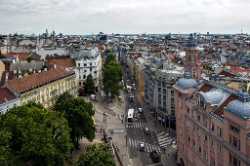
Vienna: A Symphony of History, Intrigue, and Timeless Elegance Vienna, the heart of Austria and a city consistently lauded for its unparalleled quality of life, is far more than just a picturesque European capital. It is a living, breathing testament to centuries of imperial grandeur, artistic innovation, and a unique cultural tapestry woven from threads of music, intellect, and a certain joie de vivre that permeates its very air. To merely pass through Vienna is to glimpse its beauty; to truly experience it is to be drawn into a captivating narrative filled with fascinating anecdotes and compelling reasons to linger, to explore, and to understand why this city holds such an enduring allure. Imagine a city where the ghost of Mozart's melodies still dances in the cobblestone streets, where the opulent palaces of the Habsburg emperors stand as silent witnesses to a dynasty that shaped European history, and where the very invention of the snow globe occurred by happy accident. Vienna is a city of such intriguing juxtapositions and unexpected delights, a place where the weight of history feels remarkably lightened by a vibrant contemporary spirit. One cannot speak of Vienna without acknowledging its profound musical heritage. This is a city that has nurtured more famous composers than perhaps any other on Earth. Names like Mozart, Beethoven, Haydn, Schubert, Brahms, and the Strauss dynasty are inextricably linked to Vienna, their genius echoing through its concert halls, opera houses, and even the charming Heuriger wine taverns. The Vienna State Opera, a magnificent neo-Renaissance building, stands as a global beacon of operatic excellence, its stage having hosted the world's most celebrated voices. To attend a performance here is not merely to witness a spectacle; it is to partake in a tradition that has defined Vienna for centuries. Similarly, the Musikverein, with its legendary Golden Hall, is revered for its acoustics and the annual New Year's Concert by the Vienna Philharmonic, a globally televised event that broadcasts Vienna's musical soul to the world. But Vienna's musical story is not confined to grand performances. The city's very fabric seems to hum with a melodic undercurrent. Strolling through its parks, one might stumble upon impromptu concerts or the strains of a lone violinist. The numerous churches, with their soaring architecture, often host breathtaking organ recitals. Even the traditional coffee houses, those havens of intellectual discourse and Viennese charm, have often served as meeting places for composers and musicians, their conversations and collaborations contributing to the city's rich sonic landscape. Beyond the realm of music, Vienna boasts an imperial history that has left an indelible mark on its cityscape. The Hofburg Palace, a sprawling complex that served as the winter residence of the Habsburg emperors for over six centuries, is a city within a city. Its opulent state rooms, the Sisi Museum offering a glimpse into the life of the enigmatic Empress Elisabeth, and the Imperial Treasury housing dazzling artifacts, all speak volumes of the power and prestige wielded by this dynasty. To wander through its courtyards and halls is to step back in time, imagining the lives of those who shaped European history within these very walls.

Prague is not just a capital city—it’s a fairytale stitched into the landscape of Europe. Sitting gracefully on the banks of the Vltava River, the Czech Republic’s crown jewel is often called the “City of a Hundred Spires,” though that number barely scratches the surface. With its timeless blend of Gothic, Baroque, Renaissance, and Art Nouveau architecture, Prague offers a visual journey through centuries, wrapped in red rooftops, ornate domes, and cobbled streets echoing with stories. This city has been a cultural and political crossroads for over a millennium. Founded during the Romanesque period and blossoming under Charles IV in the 14th century, Prague became the seat of the Holy Roman Empire. Charles University, established in 1348, still thrives as one of Europe’s oldest and most respected universities. The Charles Bridge—lined with 30 statues and spanning the Vltava since 1357—is both a masterpiece and a magnet for sunrise photographers, artists, and lovers alike. Wander into Old Town Square and you’ll find the legendary Astronomical Clock, installed in 1410. Every hour, it puts on a show as figures of Death, Vanity, and Greed come to life, a performance that's enchanted viewers for over 600 years. Just steps away, gothic towers rise from the Church of Our Lady before Týn, casting shadows across the square where markets, protests, and celebrations have unfolded for generations. Prague Castle, overlooking the city, is the largest ancient castle complex in the world. Within its walls lies St. Vitus Cathedral, a stunning example of Gothic architecture with stained-glass windows that flood the space with color. The cathedral took nearly 600 years to complete—proof that Prague doesn’t rush beauty. The city’s literary soul pulses through the legacy of Franz Kafka, the Prague-born writer whose surreal, introspective works have left a global mark. His presence still lingers—there’s even a rotating metal sculpture of his head, built in 2014, that mesmerizes passersby near Národní třída. Though steeped in history, Prague is no museum piece. It’s alive with jazz echoing from cellar clubs, students chattering in hidden courtyards, and the clinking of beer mugs in cozy pubs. Czech beer is among the best in the world, with a brewing tradition dating back over a thousand years. Pilsner was born in nearby Plzeň, and in Prague, classics like U Fleků have been serving their house lager for centuries. Prague also played a key role in modern history. It was the stage of the Prague Spring in 1968 and the Velvet Revolution in 1989, when peaceful protests helped end communist rule. Václav Havel, a playwright-turned-president, embodied the power of art and thought to shape a nation. Beyond the tourist trails, neighborhoods like Vinohrady and Žižkov offer local charm, leafy parks, and bohemian cafés. Petřín Hill, with its miniature Eiffel Tower and mirror maze, provides panoramic views, while Letná Park’s metronome stands where a massive Stalin statue once loomed, reminding visitors of the city’s evolving story. Prague doesn’t dazzle with speed—it enchants with layers. It’s a place where every alley could hide a story, every statue could whisper a legend. Whether blanketed in snow or lit by the golden haze of a spring sunset, the city holds a timeless kind of magic that lingers long after you've left.
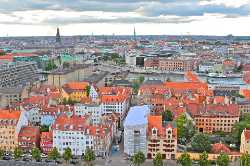
Copenhagen is where fairytales meet cutting-edge design, a city where royal history and modern minimalism dance side by side. The capital of Denmark sits gracefully on the coastal islands of Zealand and Amager, overlooking the Øresund Strait. While it may be known as the home of Hans Christian Andersen, Copenhagen is far more than a storybook setting—it’s a vibrant, progressive city pulsing with creativity, sustainability, and a deep love of life’s simple pleasures. Founded more than 850 years ago as a small fishing village, Copenhagen has transformed into one of the most livable cities in the world. Its streets are lined with colorful buildings, artfully restored warehouses, and cafés that spill onto cobbled lanes. But what truly sets the city apart is how effortlessly it blends history with innovation. In one moment, you might stroll past the majestic Amalienborg Palace where the Danish royal family still resides, and in the next, find yourself admiring a sleek, glass-fronted design museum or sipping coffee in a minimalist café with furniture straight out of a style magazine. The spirit of Copenhagen is best captured on two wheels. This is a city built for bicycles. With more bikes than people and over 375 kilometers of dedicated bike lanes, Copenhagen has long been the global capital of cycling. Locals of all ages ride year-round, in sun or snow, dressed in everything from suits to summer dresses. It’s a symbol of the city’s deep commitment to sustainability and quality of life. Copenhageners are known for embracing hygge—the Danish word that roughly translates to cozy contentment. It's a way of life here, whether found in candlelit dinners, warm conversations, or curling up in a snug nook during the long northern winters. That love of comfort extends to the city’s dining scene, which punches far above its weight. Copenhagen is home to Noma, repeatedly voted the best restaurant in the world, as well as a thriving food culture that stretches from high-end tasting menus to vibrant street food markets like Reffen and Torvehallerne. The city is also steeped in tales of kings and queens, and nowhere is this more evident than at Rosenborg Castle, a Renaissance jewel surrounded by rose gardens and the home of Denmark’s royal crown jewels. Not far from there, Tivoli Gardens—a 19th-century amusement park right in the heart of the city—has delighted visitors with its glowing lanterns, vintage rides, and open-air concerts since 1843. Walt Disney visited Tivoli before creating Disneyland, inspired by its magical charm. Copenhagen’s harbor is so clean you can swim in it, and people do—especially at Islands Brygge, where sunbathers lounge on wooden piers during the summer. Along the waterfront, you’ll find one of the city’s most iconic sights: the Little Mermaid statue, sitting quietly on a rock since 1913, inspired by Andersen’s poignant fairytale. The Danish capital is also a haven for culture lovers. The Royal Danish Theatre offers world-class ballet and opera, while the city’s many museums, like the National Gallery and the Louisiana Museum of Modern Art just outside town, showcase everything from Viking treasures to contemporary installations. Street art, independent fashion, and experimental architecture make neighborhoods like Nørrebro and Vesterbro buzz with youthful, international energy.
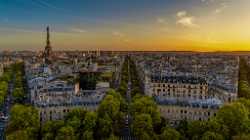
Paris is more than a destination—it is a feeling, a rhythm, a mosaic of art, romance, and reinvention. Nestled along the banks of the River Seine, the capital of France has seduced travelers, artists, and dreamers for centuries. From the glittering iron lacework of the Eiffel Tower to the cobbled charm of Montmartre, every street corner tells a story, every building seems to hold a secret, and every café invites you to linger just a little longer. Founded in the 3rd century BCE by a Celtic tribe called the Parisii, the city has grown through empire, revolution, and renaissance into one of the most iconic and visited places on Earth. Often called "La Ville Lumière"—The City of Light—Paris earned its nickname not only because it was one of the first cities to adopt gas street lighting, but also because it has long been a beacon of culture, science, and enlightenment. It is a place where ideas flourish and beauty is taken seriously, sometimes even considered a civic duty. Paris is a masterpiece of urban planning. In the 19th century, Baron Haussmann’s wide boulevards, manicured parks, and uniform cream-colored façades transformed the medieval city into a model of modern elegance. Today, these grand avenues lead to some of the world’s most treasured landmarks: the Arc de Triomphe, the Notre-Dame Cathedral, and the Louvre—home to the Mona Lisa, who gazes out from behind bulletproof glass with timeless mystery. Despite its grandeur, Paris is also a city of intimate pleasures. You can spend hours in a tiny bookshop along the Left Bank, browse open-air markets for artisan cheese, or sip espresso at a sidewalk café where Hemingway once wrote. The scent of fresh baguettes drifts from boulangeries each morning, while in the evening, the warm glow of wine bars fills the air with conversation. Time moves differently in Paris—unhurried, indulgent, and rich with nuance. Art and fashion pulse through the city’s veins. The Musée d'Orsay, housed in a former railway station, boasts the world's most extensive collection of Impressionist works. Just across the river, the Centre Pompidou challenges visitors with bold, modern design. Paris is also the cradle of haute couture, where names like Chanel, Dior, and Saint Laurent set the rhythm of global style. Twice a year, Paris Fashion Week turns the city into a glittering runway, attracting icons from every corner of the world. Beyond its beauty, Paris has long been a stage for revolution and reform. The storming of the Bastille in 1789 sparked the French Revolution and echoed across the globe. In the 20th century, existentialist philosophers like Sartre and de Beauvoir debated freedom and meaning in Saint-Germain cafés, while students in 1968 nearly shook the republic to its core. Through upheaval and rebirth, Paris has remained a city that thinks deeply and acts boldly. The French capital is also green in spirit, with sprawling parks like the Luxembourg Gardens and the Bois de Vincennes offering refuge from the urban hum. The city has committed itself to sustainability, with a growing network of bike paths and car-free zones, and the Seine’s embankments now welcome pedestrians, sunbathers, and skaters where once only traffic reigned. Above all, Paris enchants through its paradoxes. It is both ancient and forward-looking, refined yet rebellious, endlessly visited yet always personal. Whether you come for the Louvre or the Ladurée macarons, the Eiffel Tower or a kiss at the Pont des Arts, Paris opens itself to those willing to wander without a map, to savor without schedule, and to fall under the soft, golden spell of its endless charm.
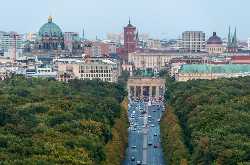
Berlin, a city pulsating with the echoes of history and the vibrant rhythm of modern life, offers a captivating tapestry woven from resilience, artistic expression, and unexpected quirks. More than just Germany's capital, Berlin is a living testament to transformation, a place where the scars of the past serve as a foundation for an intensely creative present. Consider this: Berlin boasts more bridges than Venice. This intricate network of waterways, though perhaps less romanticized than its Italian counterpart, speaks to the city's strategic location and its historical reliance on its rivers and canals for trade and transport. These liquid arteries now offer picturesque routes for boat tours and tranquil escapes from the urban bustle. Another fascinating facet of Berlin's identity lies in its surprising abundance of green spaces. Despite being a major European capital, nearly a third of Berlin is comprised of parks, forests, and lakes. The sprawling Tiergarten, once a royal hunting ground, now offers a vast green lung in the city's heart, perfect for leisurely strolls and picnics. Even Tempelhofer Feld, a former airport, has been repurposed into a unique public park, where runways now serve as cycling and skating tracks, a tangible example of Berlin's innovative spirit. Berlin's artistic soul is undeniable. Beyond the grandeur of Museum Island, a UNESCO World Heritage site housing five world-renowned museums, the city's streets themselves are a canvas for artistic expression. Street art, from vibrant murals to thought-provoking graffiti, adorns countless walls, reflecting Berlin's rebellious spirit and its embrace of alternative cultures. This raw, unfiltered creativity is a constant reminder of the city's dynamic energy. Intriguingly, Berlin has a unique relationship with currywurst, a seemingly simple street food that has become an unlikely culinary icon. This humble sausage, sliced and doused in a curried ketchup sauce, is said to have been invented in West Berlin in 1949 by Herta Heuwer, who traded some gin to British soldiers for curry powder and ketchup. Today, currywurst stands are ubiquitous throughout the city, a testament to a post-war ingenuity that has become a beloved part of Berlin's identity. Furthermore, Berlin's history is etched not only in grand monuments but also in the Stolpersteine – "stumbling stones" – small brass plaques embedded in the sidewalks in front of the former homes of victims of Nazi persecution. Each plaque bears the name and fate of an individual, serving as a poignant and deeply personal reminder of the city's darkest chapter and its commitment to remembrance. Finally, Berlin's allure lies in its palpable sense of freedom and its embrace of individuality. This is a city that has weathered immense change and emerged with a unique character – resilient, open-minded, and fiercely independent. It's a place where history is not just studied but lived, where creativity flourishes in unexpected corners, and where the spirit of reinvention is a constant undercurrent. To visit Berlin is to experience a city that is constantly evolving, a place that challenges, inspires, and leaves an indelible mark on the soul.
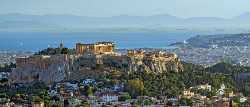
Athens, a city whose very name conjures images of ancient philosophers and iconic temples, is far more than a historical monument. It’s a vibrant, modern metropolis built upon millennia of civilization, a place where the echoes of antiquity resonate through the bustling streets of today. Consider this: Athens is one of the oldest continuously inhabited cities in the world, with evidence of settlement dating back over 5,000 years. Imagine the countless generations who have walked the same ground, their lives shaping the very stones beneath your feet. This incredible longevity imbues the city with a unique sense of timelessness, a palpable connection to the distant past that few other urban centers can claim. Intriguingly, Athens wasn't always Greece's sole capital. For a brief period in the 19th century, after the Greek War of Independence, the charming coastal town of Nafplio held the honor. It was Athens' profound historical and cultural significance that ultimately led to its reinstatement as the nation's heart, a testament to its enduring symbolic power. Another fascinating aspect of Athens lies in its surprising number of hills. While the Acropolis, meaning "high city," is the most famous, the city is also dotted with other significant elevations like Lycabettus Hill, offering panoramic vistas, and the Areopagus, the ancient court of appeal. This varied topography provides a dynamic urban landscape and numerous vantage points from which to admire the city's sprawl and the surrounding mountains. Beyond its well-known ancient sites, Athens boasts a thriving contemporary arts scene. The streets of neighborhoods like Psiri and Exarcheia are alive with street art, independent galleries, and a rebellious energy that provides a stark yet compelling contrast to the classical grandeur. This modern creative pulse demonstrates that Athens is not just a city of the past, but a living, breathing cultural hub. Furthermore, the construction of the Athens Metro system unexpectedly unearthed a wealth of archaeological treasures. During the digging process, numerous artifacts from the city's long history were discovered, and many of these finds are now displayed within the metro stations themselves, offering commuters a unique glimpse into Athens' rich past as they go about their daily lives. Finally, the very name of Athens is steeped in mythology. Legend tells of a contest between the goddess Athena and the sea god Poseidon to become the city's patron. Athena's gift of the olive tree, symbolizing peace and prosperity, was chosen over Poseidon's saltwater spring, forever linking the city to the goddess of wisdom and strategic warfare. To walk through Athens is to walk in a city named by the gods, a place where myth and history are inextricably intertwined, offering a profound sense of connection to the very foundations of Western civilization.

Budapest, a city bisected by the majestic Danube, hums with a unique energy born from the confluence of thermal springs, imperial history, and a distinctly resilient spirit. Forget predictable tourist tropes; Budapest offers a deeper dive into a captivating narrative woven with unexpected threads. Consider this: beneath the city's elegant facade lies an extensive network of caves, the largest thermal cave system in the world. These subterranean wonders, formed by the very same mineral-rich waters that feed Budapest's famed spas, can be explored, revealing a hidden world of geological marvel. This "City of Caves" offers an intriguing counterpoint to its grand architecture above ground. Intriguingly, Budapest wasn't always a singular entity. It was born in 1873 from the unification of three distinct towns: Buda, Óbuda, and Pest, each retaining its own character and charm. Buda, with its hilly terrain and historic castle district, exudes a regal air, while Pest, sprawling on the eastern bank, pulses with urban vibrancy and cultural dynamism. This triune origin contributes to the city's multifaceted personality. Another fascinating aspect of Budapest lies in its pioneering spirit in transportation. The city boasts the second-oldest metro line in the world after London's, and the first on continental Europe. Opened in 1896, the Millennium Underground (Line M1) is a UNESCO World Heritage site in itself, its charming yellow trains a nostalgic reminder of a bygone era. Beyond its architectural and subterranean wonders, Budapest holds a poignant claim to a surprising invention: the Rubik's Cube. Ernő Rubik, the puzzle's ingenious creator, was born in Budapest, his creation becoming a global phenomenon that continues to challenge and fascinate. This connection to a world-renowned puzzle speaks to the city's intellectual curiosity and innovative spirit. Furthermore, the Hungarian language, the official tongue of Budapest, is an enigma to most Europeans. Belonging to the Finno-Ugric language family, it shares closer ties with Finnish and Estonian than its Slavic or Germanic neighbors. Its unique grammar and vocabulary make it a fascinating linguistic puzzle, reflecting Hungary's distinct cultural heritage in the heart of Europe. Finally, standing tall on the Pest side of the Danube, the Hungarian Parliament Building is not just a stunning example of Gothic Revival architecture; its height is deliberately symbolic. At 96 meters tall, it shares the same elevation as St. Stephen's Basilica, a height chosen to commemorate the year 896 AD, the traditional date of the Magyar conquest of the Carpathian Basin. No other building in Budapest is permitted to surpass this height, a subtle yet powerful nod to the nation's founding. To wander Budapest is to encounter a city where history, innovation, and a touch of playful mystery intertwine, creating an experience far richer than any simple list of sights could convey.
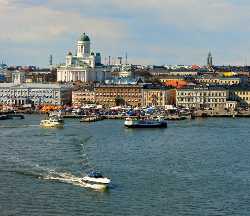
Helsinki, a city gracing the Finnish peninsula on the Gulf, offers a compelling blend of Nordic efficiency and surprising historical layers. It wasn't always the nation's obvious heart; for a time under Swedish rule, Turku held the capital status, a detail that underscores the shifting power dynamics of the Baltic region. Yet, Helsinki's strategic coastal location destined it for greater things. Consider its foundation: King Gustav Vasa of Sweden established Helsinki in 1550 with the aim of creating a trading hub to rival Tallinn. This ambition, however, didn't immediately translate to a bustling metropolis. For centuries, it remained a rather modest settlement, its growth stunted by conflicts and even a devastating plague in the early 18th century. This slow burn of development adds an intriguing dimension to its current standing as a vibrant capital. Intriguingly, much of modern Helsinki's striking neoclassical architecture owes its existence to a fire. A significant blaze in the early 19th century cleared the way for a grand redesign spearheaded by German-born architect Carl Ludvig Engel, invited by the Russian Tsar after Finland became a Grand Duchy within the Russian Empire in 1809. This Russian influence on Helsinki's cityscape, intended to align it more closely with St. Petersburg, offers a unique visual narrative. Beyond its architectural evolution, Helsinki boasts a remarkable connection to the sea, with over 300 islands within its city limits. This archipelago isn't just a scenic backdrop; it's integral to the city's identity, offering residents and visitors alike opportunities for island hopping, recreation, and a tangible link to Finland's maritime heritage. Furthermore, Helsinki has a somewhat unexpected nickname: "The White City of the North." This moniker isn't due to its winter snowscapes, though those are certainly picturesque, but rather to the prevalence of light-colored granite used in the construction of many of its prominent buildings, creating a distinct visual harmony. Finally, for those with a penchant for linguistic trivia, the Finnish language spoken in Helsinki is famously challenging for outsiders. Its unique grammar and vocabulary, belonging to the Finno-Ugric family, set it apart from most other European languages, offering a fascinating glimpse into Finland's distinct cultural and historical roots. To explore Helsinki is to uncover a capital shaped by Swedish ambition, Russian influence, devastating events, and a deep connection to the surrounding Baltic Sea, all contributing to its unique and compelling character.
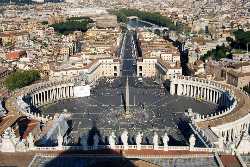
Rome, the Eternal City, whispers tales from every cobblestone, a metropolis built not just on seven hills but on layers of captivating history and surprising anecdotes. It wasn't always destined for such grandeur; legend claims its founder, Romulus, famously dispatched his twin brother Remus in a dispute over the city's nascent boundaries, a rather dramatic origin story for such an enduring capital. Consider this: Rome wasn't just the center of a vast empire; it was a pioneer in urban planning. The Romans constructed an intricate network of roads, aqueducts, and sewers, marvels of engineering for their time. The saying "All roads lead to Rome" wasn't just a figure of speech; by the early fourth century AD, they had built over 53,000 miles of paved roads, facilitating trade and communication across their vast territories. Intriguingly, the iconic Spanish Steps aren't Spanish at all. Despite their name, these elegant 18th-century steps were designed by an Italian architect, Francesco de Sanctis, funded by a French diplomat. The name derives from the Piazza di Spagna at their base, which housed the Spanish Embassy to the Holy See. This linguistic twist adds a layer of unexpected international intrigue to a beloved landmark. Another fascinating aspect of Rome lies in its unique relationship with its feline inhabitants. A law passed in 1991 allows cats to live freely and without disturbance in the areas where they were born. Consequently, you'll often spot these furry residents lounging amongst the ancient ruins of the Forum or basking in the sun on the Colosseum walls, a charming and very Roman sight. Beyond its monumental history, Rome boasts a surprising claim as the location of the world's first shopping mall. Emperor Trajan's Market, built between 107 and 110 AD, was a multi-level complex housing over 150 shops selling everything from food to clothes, a testament to Rome's early understanding of commerce and urban life. Finally, the seemingly ubiquitous "SPQR" emblazoned on Roman buildings and monuments isn't some arcane decoration. It's an abbreviation for "Senatus Populusque Romanus," meaning "The Senate and People of Rome." This powerful acronym served as the official emblem of the Roman Republic and Empire, a constant reminder of the source of their authority and a symbol that still resonates throughout the city today. To wander through Rome is to traverse not just geographical space, but millennia of captivating stories and unexpected details, a journey where the past constantly intertwines with the vibrant present.
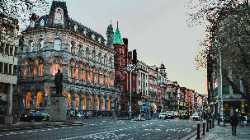
Dublin, a city where the spirited lilt of the Irish accent intertwines with the lively strumming of a pub session, offers a charm that extends far beyond its famed hospitality. It wasn't always the island's primary hub; for centuries, other settlements held sway, their influence eventually yielding to Dublin's strategic coastal position and burgeoning Viking roots. Consider this: Dublin's origins can be traced back to a Viking settlement in the 9th century. The name "Dublin" itself is believed to derive from the Old Irish "Dubh Linn," meaning "black pool," likely referring to a dark tidal pool at the confluence of the River Liffey and the River Poddle. This Norse heritage adds a layer of fascinating history beneath the city's more recent Georgian elegance. Intriguingly, Dublin boasts a surprising connection to Bram Stoker, the author of the iconic vampire novel "Dracula." Stoker was born in Dublin, and while the Transylvanian setting of his masterpiece might seem far removed from the Irish capital, some scholars suggest that Dublin's own folklore and perhaps even its shadowy alleyways may have subtly influenced his gothic imagination. Another fascinating aspect of Dublin lies in its abundance of literary connections. It has been home to a remarkable number of literary giants, including James Joyce, William Butler Yeats, Samuel Beckett, and George Bernard Shaw, earning it a UNESCO City of Literature designation. Walking its streets, you can almost feel the echoes of their conversations in the pubs and their inspiration in the city's landscapes. Beyond its historical and literary significance, Dublin holds a unique claim to a rather unusual sporting tradition: hurling. This ancient Gaelic sport, often described as a cross between hockey, lacrosse, and rugby, is fiercely popular in Ireland, and Dublin has its own passionate hurling community, offering visitors a chance to witness a truly unique and exhilarating spectacle. Furthermore, Dublin's iconic Guinness Storehouse isn't just a brewery tour; it's a journey through the history and culture of Ireland's most famous export. From its origins in 1759 when Arthur Guinness signed a 9,000-year lease on the St. James's Gate Brewery, to the panoramic views of Dublin from the Gravity Bar, it's an immersive experience that goes beyond just the brewing process. Finally, the vibrant street art scene that has emerged in Dublin in recent years offers a contemporary counterpoint to its historical architecture. Colorful murals and thought-provoking installations can be found throughout the city, particularly in areas like Temple Bar and Portobello, showcasing Dublin's evolving artistic identity and its embrace of modern forms of expression. To explore Dublin is to encounter a city where Viking roots meet Georgian grandeur, where literary ghosts mingle with lively pub conversations, and where ancient traditions find new expression in a vibrant modern setting.

Amsterdam, a city laced with picturesque canals and brimming with a unique liberal spirit, offers a tapestry of intriguing details beyond its well-trodden paths. It wasn't always the Netherlands' primary center; for a time, cities like The Hague held significant political sway, a reminder that Amsterdam's current prominence evolved over centuries. Consider this: Amsterdam is famously built on millions of wooden poles. This seemingly precarious foundation is due to the city's marshy terrain. These submerged pillars, some dating back centuries, silently support the weight of its iconic canal houses, a testament to ingenious early engineering that continues to defy the watery landscape. Intriguingly, Amsterdam boasts more bicycles than inhabitants. This two-wheeled dominance shapes the city's rhythm, with dedicated bike lanes forming a complex network often prioritized over car traffic. The sheer volume of bicycles, however, leads to an unusual problem: thousands end up in the canals each year, requiring specialized retrieval efforts. Another fascinating aspect of Amsterdam lies in its historical role as a haven for religious and intellectual freedom. During the 17th-century Golden Age, the city welcomed those fleeing persecution elsewhere in Europe, fostering a vibrant intellectual climate that attracted thinkers and artists like Rembrandt and Spinoza, contributing to a period of unprecedented cultural flourishing. Beyond its iconic canals, Amsterdam is home to the world's only floating flower market, the Bloemenmarkt. Situated along the Singel canal, this fragrant spectacle has existed since 1862, with the flower stalls traditionally located on houseboats, a charming nod to the city's intimate relationship with its waterways. Furthermore, the seemingly ordinary canal houses often conceal surprising histories. Their narrow facades, dictated in part by historical property taxes based on width, often extend deep inside, revealing hidden courtyards and intricate interiors that speak to the wealth and ingenuity of past inhabitants. Many feature distinctive hoisting hooks near the roof, a practical necessity for lifting goods to the upper storage levels. Finally, for those seeking a different kind of "coffee," Amsterdam's renowned coffee shops operate under a unique legal framework, a testament to the Netherlands' progressive social policies. These establishments, distinct from regular "koffiehuis" cafes, offer a regulated environment for cannabis consumption, a cultural nuance that often surprises first-time visitors. To explore Amsterdam is to encounter a city where innovative solutions meet a rich history of tolerance and trade, all reflected in its distinctive landscape and open-minded atmosphere.

Oslo, a city nestled at the head of its namesake fjord, offers a compelling narrative that extends far beyond its modern, often eco-conscious, reputation. It wasn't always the clear capital of Norway; for a significant period, particularly during the union with Denmark, Copenhagen held that central role, a detail highlighting the shifting political landscapes of Scandinavia. Yet, Oslo's strategic coastal location and deep historical roots ultimately cemented its importance. Consider its ancient beginnings: while the official founding year is often cited as around 1049 by King Harald Hardrada, archaeological evidence suggests Christian burials predating 1000 AD, hinting at a much earlier urban settlement. This discovery led to Oslo celebrating its millennium in 2000 rather than a later anticipated date, a testament to the ongoing uncovering of its past. Intriguingly, Oslo once bore a different name: Christiania. After a devastating fire in 1624 destroyed much of the city, the Danish-Norwegian King Christian IV decided to rebuild it further west, near the Akershus Fortress, and christened it in his own honor. It wasn't until 1925, after Norway gained full independence, that the city reclaimed its original Norse name, Oslo, a symbolic reclaiming of its national identity. Another fascinating aspect of Oslo lies in its unique tradition of gifting a Christmas tree to London's Trafalgar Square every year. This annual act of generosity is a token of gratitude for Britain's support to Norway during World War II, a poignant reminder of the solidarity between nations during times of conflict. Beyond its historical and symbolic gestures, Oslo holds the distinction of hosting the Nobel Peace Prize ceremony annually on December 10th. Unlike the other Nobel Prizes awarded in Stockholm, the Peace Prize is presented in Oslo City Hall, making it the sole Nobel Prize given outside of Sweden, underscoring Norway's commitment to peace and diplomacy. Furthermore, Oslo has taken innovative steps towards urban biodiversity by creating the world's first "bee highway." Launched in 2015, this initiative involves planting flowers and installing artificial beehives throughout the city to provide safe passage and sustenance for bees, showcasing Oslo's commitment to environmental sustainability and forward-thinking urban planning. Finally, for art enthusiasts, Oslo is home to one of the largest museums dedicated to a single artist: the Munch Museum. Housing a vast collection of over 28,000 works by the renowned expressionist Edvard Munch, including multiple versions of his iconic painting "The Scream," the museum offers an unparalleled insight into the artist's profound and often unsettling vision. To explore Oslo is to encounter a city where Viking history lies beneath a more recent royal namesake, a place that honors international cooperation while fostering unique environmental initiatives and celebrating artistic genius.
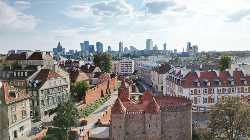
Warsaw, a city that has risen from the ashes time and again, carries a profound weight of history yet pulses with a resilient modern spirit. It wasn't always Poland's obvious capital; Krakow held that honor for centuries, a testament to the shifting centers of power within the Polish kingdom. Yet, Warsaw's strategic location on the Vistula River eventually propelled it to the forefront. Consider this: Warsaw earned the poignant nickname "Phoenix City." During World War II, the city was systematically razed to the ground by Nazi forces in retaliation for the Warsaw Uprising of 1944. Over 85% of its buildings were destroyed. However, with incredible determination, its citizens meticulously rebuilt the Old Town, brick by brick, using pre-war photographs and architectural plans. This remarkable feat of reconstruction led UNESCO to inscribe the Old Town as a World Heritage site, a symbol of human resilience. Intriguingly, Warsaw is home to the narrowest house in the world. Tucked between two existing buildings, Keret House measures a mere 152 centimeters at its widest point and only 92 centimeters at its narrowest. Designed by architect Jakub Szczęsny, this artistic installation serves as a temporary home for traveling writers, a quirky testament to Warsaw's creative and unconventional spirit. Another fascinating aspect of Warsaw lies in its surprising abundance of green spaces. Despite being a bustling capital, over 25% of the city is covered in parks, forests, and nature reserves. Łazienki Park, with its palaces and free summer Chopin concerts, and the vast Kampinos National Park on the city's outskirts, offer tranquil escapes from urban life, showcasing a deep appreciation for nature within the city limits. Beyond its historical and natural attractions, Warsaw boasts a unique culinary icon: pyzy. These large, oval potato dumplings, often served with skwarki (pork scratchings) or gulasz (goulash), are a distinctly Warsaw specialty, a hearty and comforting dish that reflects the city's culinary heritage and provides a taste of local tradition. Furthermore, Warsaw is the only city in Poland with a functioning metro system. The first line opened in 1995, and its expansion continues to this day, providing an efficient way to navigate the sprawling city. The metro has even found its way into popular culture, referenced in songs and becoming an integral part of the daily lives of Varsovians. Finally, the symbol of Warsaw is a mermaid, known as Syrenka. Legend has it that this mythical creature swam up the Vistula River and, liking the area, decided to stay. When some greedy merchants tried to capture her, she was rescued by a brave fisherman. Ever since, Syrenka has stood as the protector of Warsaw, a fierce and independent symbol embodying the city's spirit. To explore Warsaw is to encounter a city that has endured immense hardship yet emerged with a unique blend of historical reverence, creative innovation, and an indomitable spirit, symbolized by a mermaid guarding its resilient heart.
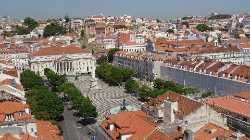
Lisbon, a city draped across seven hills overlooking the Tagus River, whispers tales of seafaring explorers and melancholic Fado melodies from its sun-drenched streets. It wasn't always Portugal's undisputed capital; for a time, Coimbra held that central role, a detail that speaks to the shifting tides of power in the Iberian Peninsula. Yet, Lisbon's strategic port location ultimately destined it for a prominent future. Consider this: Lisbon is reputedly older than Rome. Archaeological findings suggest Phoenician traders established a settlement here around 1200 BCE, predating the legendary founding of the Eternal City. This ancient lineage imbues Lisbon with a profound sense of history, its very soil holding echoes of civilizations long past. Intriguingly, the iconic yellow trams that rattle through Lisbon's narrow, winding streets are not entirely Portuguese in origin. Many of these charming eléctricos are actually American, modeled after trams that once traversed the streets of Harlem and New Orleans. Locals even affectionately nicknamed them "Americanos," a nod to their surprising heritage. Another fascinating aspect of Lisbon lies in its connection to a global culinary icon: tea time. Catherine of Braganza, a Portuguese princess who married King Charles II of England in the 17th century, is credited with popularizing tea drinking in the British court, thus introducing a ritual enjoyed worldwide. This seemingly small detail highlights Lisbon's unexpected influence on global customs. Beyond its historical and cultural contributions, Lisbon holds a unique record as home to the oldest bookstore in the world still in operation. Livraria Bertrand, located in the Chiado district, first opened its doors in 1732 and has been continuously selling books ever since, earning it a Guinness World Record and making it a must-visit for literary enthusiasts. Furthermore, Lisbon's patron saint, Saint Vincent, is said to have had his remains brought to the city by a boat guided by ravens. These birds became a symbol of Lisbon, often depicted on its coat of arms, and for centuries, a flock of ravens was even kept at the Sé Cathedral, a tangible link to this legendary tale. Finally, the entire Baixa Pombalina district, the elegant, grid-patterned downtown area, is a testament to resilience. It was completely rebuilt after the devastating 1755 earthquake and tsunami, a feat of 18th-century urban planning led by the Marquis of Pombal. The grand avenues and neoclassical architecture stand as a powerful reminder of Lisbon's ability to rise from the ashes and reinvent itself. To wander through Lisbon is to encounter a city where ancient roots intertwine with surprising global connections, all set against a backdrop of stunning architecture and a melancholic yet captivating spirit.

Bucharest, a city often dubbed "Little Paris" for its Belle Époque architecture and once-vibrant cultural scene, carries a history far more complex and intriguing than a simple nickname suggests. It wasn't always the undisputed heart of Romania; for a time, Târgoviște served as the princely capital of Wallachia, a detail highlighting the shifting centers of power in the region. Yet, Bucharest's strategic location on the plains eventually propelled it to prominence. Consider this: Bucharest holds the distinction of being the first capital city in the world to have its streets illuminated by kerosene lamps in the mid-19th century. This early adoption of modern lighting technology earned it a reputation for sophistication and progress, contributing to its "Little Paris" moniker. Imagine the transformative effect of gaslight on a city previously shrouded in darkness. Intriguingly, beneath the bustling modern city lies a network of tunnels and catacombs, some dating back centuries. These subterranean passages have served various purposes throughout history, from storage to potential escape routes, adding a layer of mystery and hidden history to the urban landscape. Exploring these forgotten depths offers a unique perspective on Bucharest's past. Another fascinating aspect of Bucharest is the Palace of the Parliament, a colossal structure that holds several world records. It is the heaviest administrative building globally and one of the largest in terms of volume, second only to the Pentagon. Built during the communist era under Nicolae Ceaușescu, its sheer scale and opulent interiors stand as a testament to a bygone era's ambition and extravagance, a stark contrast to the lives of ordinary citizens at the time. Beyond its monumental architecture, Bucharest boasts a surprisingly rich artistic heritage. It was home to influential figures like Constantin Brâncuși, a pioneer of modern sculpture, and George Enescu, a renowned composer and violinist. Their legacies are celebrated in various museums and cultural institutions throughout the city, showcasing Bucharest's significant contributions to the world of art and music. Furthermore, the Romanian Athenaeum, an iconic circular building in the heart of the city, is not just a stunning architectural landmark but also a symbol of Romanian culture and intellect. Its frescoed dome depicts scenes from Romanian history, and its concert hall is home to the George Enescu Philharmonic Orchestra, a testament to the city's enduring passion for the arts. Finally, the legend of the city's founding offers a charmingly pastoral image. It is said that a shepherd named Bucur, whose name translates to "joy," settled on the banks of the Dâmbovița River, his melodious flute attracting others and eventually leading to the establishment of a village that grew into the city of Bucharest. This folkloric origin provides a gentle and evocative contrast to the grand historical narratives that have shaped the capital. To explore Bucharest is to encounter a city of compelling contrasts, where echoes of a sophisticated past intertwine with the imposing remnants of a more recent, complex history, all set against a backdrop of surprising cultural richness and enduring spirit.
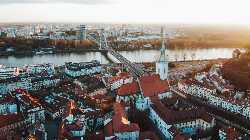
Bratislava, the charming capital of Slovakia, often surprises visitors with its intriguing blend of historical significance and quirky modern touches. Nestled along the majestic Danube River, it holds a unique geographical distinction: it's the only capital city in the world that directly borders two independent countries, Austria and Hungary, a fact that has profoundly shaped its multicultural heritage. This tri-border location, just a stone's throw from Vienna, has fostered a rich tapestry of influences throughout its long history. Speaking of names, Bratislava hasn't always been known as such. Throughout its dynamic past, it has been called Pressburg in German, Pozsony in Hungarian, and Prešporok in Slovak, each moniker reflecting the dominant cultural influence of the time. The official adoption of the name Bratislava only occurred in 1919, following the creation of Czechoslovakia after World War I, a deliberate choice to emphasize its Slavic roots. For centuries, Bratislava held a vital role as the coronation city for the Kingdom of Hungary, a period that lasted from 1563 to 1830. During this significant era, no fewer than nineteen Habsburg monarchs, including the formidable Maria Theresa, were crowned in the magnificent St. Martin's Cathedral. The cathedral's tower still bears a replica of the Hungarian royal crown, a gleaming reminder of the city's regal past. To walk the Coronation Route, marked by brass crowns embedded in the pavement, is to trace the steps of emperors and queens. Adding a touch of the unexpected to Bratislava's skyline is the Nový Most, or New Bridge, often referred to as the UFO Bridge due to the distinct flying saucer-shaped structure perched atop its single pylon. This futuristic design, offering panoramic views of the city and the Danube, stands in stark contrast to the medieval charm of the Old Town, symbolizing Bratislava's embrace of modernity while acknowledging its history. Scattered throughout Bratislava's enchanting Old Town, a collection of whimsical statues adds a playful element to its historical ambiance. Perhaps the most photographed is Čumil, "The Watcher," a bronze figure peeking out from a manhole with a mischievous grin. Then there's Schöne Náci, a dapper gentleman eternally tipping his hat to passersby, a tribute to a beloved local eccentric of the past. These quirky artistic additions inject a sense of humor and approachability into the city's historical fabric. Bratislava's deep connection to classical music is another compelling facet of its identity. Renowned composers such as Franz Liszt and Béla Bartók graced its halls with their performances, and the city proudly boasts the Slovak Philharmonic Orchestra, one of the oldest in Europe. Even a young Wolfgang Amadeus Mozart is believed to have given a concert in Bratislava in 1762, a testament to the city's long-standing appreciation for musical excellence. These intriguing details, far from being mere footnotes, illuminate the multifaceted character of Bratislava, a city where imperial echoes resonate alongside modern innovation and a playful artistic spirit. To visit Bratislava is to uncover a capital that seamlessly blends its rich history with a vibrant contemporary life, offering a unique and captivating experience for all who explore its charming streets.

Madrid, the vibrant heart of Spain, pulsates with a passionate energy that extends far beyond its renowned art museums and grand boulevards. It wasn't always the undisputed capital; for a significant period, Toledo held that esteemed position, a detail highlighting the shifting political landscapes of the Iberian Peninsula. Yet, Madrid's central location and royal patronage eventually propelled it to the forefront of Spanish power. Consider this: Madrid is geographically one of the highest capital cities in Europe, sitting at an average altitude of around 667 meters (2,188 feet) above sea level. This elevated position contributes to its dry climate and offers surprisingly crisp air, especially in the cooler months, a stark contrast to the often-humid coastal regions of Spain. Intriguingly, the iconic Puerta del Sol, one of Madrid's most famous squares, marks the exact center of Spain. A plaque on the ground, known as the "Kilómetro Cero," signifies the starting point for all of Spain's national roads. This symbolic location makes it a natural meeting point and a place where the entire nation figuratively converges. Another fascinating aspect of Madrid lies in its surprising connection to a beloved children's character: Paddington Bear. The creator of the marmalade-loving bear, Michael Bond, was inspired to write the first Paddington story after seeing refugee children arriving in London during World War II, often with labels attached to their coats. The name "Paddington" came from the London railway station, but Bond's wife was of Spanish origin, and his frequent visits to Spain may have subtly influenced some of the bear's charmingly polite and slightly bewildered demeanor. Beyond its geographical and literary links, Madrid boasts a unique tradition associated with New Year's Eve. As the clock strikes midnight on December 31st, thousands of people gather in Puerta del Sol to eat twelve grapes, one for each chime, a ritual believed to bring good luck for the coming year. This lively and slightly chaotic tradition is a distinctly Madrileño way to ring in the new year. Furthermore, the magnificent Royal Palace of Madrid, while the official residence of the Spanish Royal Family, is primarily used for state ceremonies. The current monarchs actually reside in the more modest Zarzuela Palace on the outskirts of the city, a detail that offers a glimpse into the more private lives of the Spanish royals. Finally, for those with a sweet tooth, Madrid is the birthplace of churros. These fried dough pastries, often served with thick, rich chocolate for dipping, are a quintessential Madrileño treat, enjoyed for breakfast, as a snack, or even late at night after a lively evening. The aroma of freshly fried churros wafting from local churrerías is an integral part of the Madrid experience. To explore Madrid is to encounter a city where its elevated position mirrors its historical importance, a place marked by a symbolic national center, literary inspiration, unique traditions, and a deeply ingrained love for sweet delights.
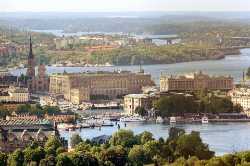
Stockholm, a city gracefully spread across fourteen islands where Lake Mälaren meets the Baltic Sea, offers a captivating blend of stunning natural beauty and innovative urban design. It wasn't always Sweden's obvious capital; for a significant period, Uppsala held that esteemed position, its historical and religious significance eventually yielding to Stockholm's strategic coastal location and burgeoning trade. Consider this: Stockholm's iconic subway system, the Tunnelbana, is often referred to as the "longest art gallery in the world." Stretching over 110 kilometers, many of its stations are adorned with unique sculptures, mosaics, paintings, and installations by various artists, transforming the daily commute into an unexpected cultural experience. Imagine descending into the earth to be greeted by vibrant artwork carved directly into the bedrock. Intriguingly, Stockholm has a deep and somewhat surprising connection to the Nobel Prizes. Alfred Nobel, the Swedish chemist and engineer who invented dynamite, established the prestigious awards in his will. While the Nobel Prizes in Physics, Chemistry, Physiology or Medicine, and Literature are awarded in Stockholm, the Nobel Peace Prize is uniquely awarded in Oslo, Norway, a historical quirk stemming from the personal union between Sweden and Norway in the 19th century. Another fascinating aspect of Stockholm lies in its historical role as the namesake for a psychological phenomenon: Stockholm Syndrome. This term arose following a 1973 bank robbery in Stockholm where the hostages developed an emotional bond with their captors, a complex human response that continues to be studied and discussed. Beyond its cultural and psychological connections, Stockholm boasts a unique tradition associated with crayfish. "Kräftskiva," or crayfish parties, are a beloved late-summer ritual in Sweden, involving copious amounts of boiled crayfish, dill, schnapps, and singing traditional songs. These lively gatherings, often held outdoors under paper lanterns, offer a glimpse into Swedish social customs and a hearty appreciation for seasonal delicacies. Furthermore, Stockholm's Gamla Stan, or Old Town, is home to Stortorget, the main square, which was the site of the infamous Stockholm Bloodbath in 1520, a pivotal event in Swedish history where numerous Swedish nobles were executed. The square's colorful buildings, while picturesque today, serve as a silent reminder of this dramatic past. Finally, for those with a penchant for maritime history, the Vasa Museum houses the remarkably preserved 17th-century warship Vasa, which sank on its maiden voyage in 1628 and was salvaged 333 years later. This incredibly intact ship offers a unique window into naval technology and life during that era, a tangible link to Sweden's seafaring past. To explore Stockholm is to encounter a city where subterranean art awaits daily commuters, a place deeply intertwined with global recognition of achievement, a namesake for a complex human behavior, and a city that vividly preserves both its triumphs and its tragedies.
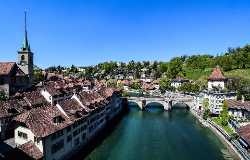
Bern, the charming capital of Switzerland, often surprises visitors with its unique character and intriguing history, far beyond its picturesque riverside setting. It wasn't always the Swiss Confederation's definitive heart; other cities like Zurich and Lucerne held significant influence at various points, a testament to Switzerland's decentralized political landscape. Yet, Bern's central location and historical significance ultimately solidified its role as the federal city. Consider this: Bern's very name is said to derive from the German word for "bear" (Bär). Legend has it that the city's founder, Duke Berthold V of Zähringen, vowed to name the settlement after the first animal he hunted in the area, and as fate would have it, that creature was a bear. This enduring connection is evident throughout the city, from the Bear Park (BärenPark) along the Aare River to countless bear motifs adorning fountains, flags, and buildings. Intriguingly, Bern's Old Town (Altstadt), a UNESCO World Heritage site, boasts an impressive network of covered arcades known as "Lauben." Stretching for over six kilometers, these unique walkways provide shelter from both sun and rain, creating a distinctive architectural feature and a delightful space for strolling, shopping, and enjoying the city's atmosphere regardless of the weather. Another fascinating aspect of Bern lies in its surprisingly relaxed pace of life. Despite being the political center of Switzerland, it exudes a small-town charm, with locals often taking their time and enjoying the simple pleasures. In fact, studies have suggested that Bern has one of the slowest average walking speeds among European capitals, perhaps reflecting this unhurried approach to life. Beyond its architectural and cultural quirks, Bern holds a significant place in scientific history. Albert Einstein lived and worked in Bern for several years in the early 20th century, while employed at the Swiss Patent Office. It was during his time in Bern that he developed his groundbreaking theory of relativity, and his former apartment is now a museum, offering a glimpse into the life of this scientific genius. Furthermore, Bern is the birthplace of the world-famous Toblerone chocolate bar. Theodor Tobler and Emil Baumann invented the distinctive triangular treat in Bern in 1908, inspired by the Matterhorn mountain. To this day, every Toblerone bar is still produced in the city, a sweet reminder of Bern's contribution to global confectionery. Finally, for a city of its size, Bern has an impressive amount of green space. The Aare River gracefully loops around the Old Town, offering opportunities for swimming and leisurely walks along its banks. The Rose Garden (Rosengarten), perched on a hill overlooking the city, provides stunning panoramic views and a fragrant escape, showcasing Bern's harmonious blend of urban living and natural beauty. To explore Bern is to encounter a city where the legend of a bear intertwines with medieval arcades, a relaxed atmosphere fostered intellectual breakthroughs, and a globally recognized chocolate was born, all contributing to its unique and captivating appeal.

Ljubljana, the captivating capital of Slovenia, often charms visitors with its intimate atmosphere and verdant embrace, yet it holds a history stretching back to Roman times when it was known as Emona. This ancient lineage quietly underpins the city's modern vibrancy. Interestingly, the very symbol of Ljubljana is a dragon, perched atop the castle tower and featured prominently on the city's coat of arms. Legend attributes this fierce creature to the Greek hero Jason, who supposedly slew a dragon in the marshes near where the city now stands during his quest for the Golden Fleece, a mythical origin story that adds a touch of fantastical intrigue to its identity. For a period in the early 19th century, during Napoleon's reign, Ljubljana held the unique distinction of being the capital of the Illyrian Provinces, a territory encompassing parts of modern-day Slovenia, Croatia, and Austria. This brief but significant moment in history positioned Ljubljana as a temporary administrative center for a larger region, exposing it to different cultural and political influences. Adding to its historical significance, Ljubljana hosted the Congress of Laibach (its German name at the time) in 1821, a meeting of European powers that shaped the political landscape following Napoleon's defeat, demonstrating its role as a stage for significant international events. The architectural landscape of Ljubljana is distinctly marked by the work of Jože Plečnik, a renowned architect who left an indelible stamp on the city in the 20th century, often compared to Gaudí's influence on Barcelona. Plečnik's masterful touch can be seen in numerous iconic structures, including the Triple Bridge, a picturesque series of three bridges spanning the Ljubljanica River, the National and University Library, and the Central Market, each showcasing his unique blend of classical and modern styles. His vision transformed Ljubljana into a cohesive and aesthetically pleasing urban environment, earning it recognition as a significant comprehensive work of art of the 20th century. Adding a touch of unexpected romance to the city are the padlocks adorning the Butcher's Bridge. Inspired by similar traditions in other European cities, couples attach padlocks engraved with their names to the bridge's railings, symbolizing their enduring love, with the keys often thrown into the Ljubljanica River below, a charming contemporary custom layered onto the city's historical fabric. Furthermore, Ljubljana proudly held the title of European Green Capital in 2016, a testament to its commitment to sustainability and its extensive network of pedestrian and cycling paths, making it a remarkably people-friendly and environmentally conscious capital. This dedication to green spaces and a car-free city center underscores a modern ethos of liveability that complements its historical charm.
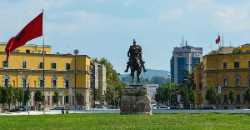
Tirana, the vibrant capital of Albania, pulsates with a unique energy born from a fascinating, often tumultuous history and a resilient spirit that’s painting the city in increasingly brighter hues. It wasn't always the definitive heart of Albania; for a brief period in the early 20th century, after the country declared independence, the coastal city of Durrës held the capital status, a detail highlighting the nascent nation's search for its center. Yet, Tirana's central location ultimately solidified its role as the nation's dynamic hub. Consider this: Tirana's cityscape underwent a remarkable transformation in the early 2000s under the leadership of its former mayor, Edi Rama, an artist by trade. He initiated a project to paint the city's drab, Soviet-era buildings in vibrant, bold colors and abstract patterns. This initiative, intended to inject life and optimism into the post-communist capital, has given Tirana a distinctive and somewhat whimsical appearance, a visual representation of its shedding its grey past for a more colorful future. Intriguingly, the very name "Tirana" has several debated origins. One theory links it to "Theranda," an ancient Greek and Latin term for the area, suggesting a long history of habitation. Another posits a connection to "Tirkan," the name of a castle in the nearby Dajti Mountains during the Byzantine era. A more romantic, though perhaps less likely, explanation attributes the name to Sulejman Pasha, the Ottoman general credited with founding the city in the early 17th century, who supposedly named it after Tehran in Persia (now Iran), where he had previously served. Another fascinating aspect of Tirana lies in its complex architectural tapestry, a visual timeline of its shifting political landscapes. Ottoman-era mosques stand alongside Italian Fascist-style buildings from the interwar period and the more austere concrete structures of the communist era. This juxtaposition of architectural styles offers a tangible representation of Albania's layered and often contradictory history, a city where minarets cast shadows on modernist facades. Beyond its visual quirks, Tirana holds a unique historical significance as the self-declared "first atheist state" in the world in 1967 under the communist regime of Enver Hoxha. This radical policy led to the closure and destruction of numerous religious buildings. However, following the fall of communism in the early 1990s, there has been a resurgence of religious freedom, with the reopening and construction of mosques, Orthodox and Catholic cathedrals, reflecting a significant shift in the country's social and spiritual landscape. Furthermore, for those seeking a glimpse into Albania's isolated past, Tirana is home to the fascinating Bunk'Art museums. These massive underground bunkers, built during the communist era to withstand potential nuclear attacks, have been transformed into unique cultural spaces showcasing art and historical exhibitions that offer a chilling yet compelling insight into a paranoid era and the resilience of the Albanian people.
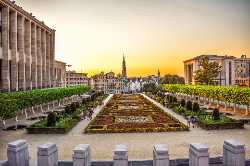
Brussels, the vibrant heart of Belgium and a city often hailed as the de facto capital of the European Union, offers a compelling tapestry woven from medieval charm, Art Nouveau elegance, and a surprisingly quirky spirit. It wasn't always the undisputed center of the region; for centuries, cities like Bruges and Ghent held significant economic and cultural sway in the Low Countries, a reminder of the shifting tides of power in this historically contested area. Yet, Brussels' strategic location and eventual role as a political hub propelled it to its current prominence. Consider this: Brussels boasts more comic strip murals than any other city in Europe. Scattered throughout its streets, these large-scale artworks pay homage to Belgium's rich comic book heritage, home to iconic characters like Tintin, the Smurfs, and Lucky Luke. This vibrant urban art gallery adds a playful and unexpected dimension to the city's architectural landscape, a testament to its embrace of popular culture. Intriguingly, the seemingly ubiquitous Manneken Pis, the small bronze statue of a peeing boy, has a surprisingly complex and debated history. While its exact origins remain shrouded in legend, various stories abound, from extinguishing a fire with a stream of urine to commemorating a lost duke. This cheeky little statue has become an enduring symbol of Brussels' independent and somewhat irreverent spirit, often dressed in elaborate costumes for special occasions. Another fascinating aspect of Brussels lies in its accidental contribution to the world of vegetables. Endive, that slightly bitter and elegant leafy green, was supposedly discovered in the 19th century in the botanical gardens of Brussels. A forgotten box of chicory roots in a dark cellar sprouted pale, elongated leaves, a serendipitous culinary discovery that has since graced tables worldwide. Beyond its artistic and culinary quirks, Brussels holds a unique linguistic identity. It sits at the crossroads of French and Dutch-speaking Belgium, resulting in a bilingual city where both languages are official. This linguistic duality is woven into the fabric of daily life, from street signs to public announcements, reflecting the country's complex cultural makeup. Furthermore, the Grand Place, Brussels' breathtaking central square, is not just a stunning example of Baroque architecture; it was once a bustling marketplace where even executions took place. The opulent guildhalls that line the square, meticulously rebuilt after being heavily damaged by French bombardment in 1695, stand as a testament to the city's resilience and its enduring economic and civic pride. Finally, for those with a sweet tooth, Brussels is a veritable paradise for chocolate lovers. From world-renowned chocolatiers to countless smaller artisanal shops, the city offers an overwhelming array of delectable pralines and truffles. The strict regulations governing Belgian chocolate ensure its high quality, making indulging in this national treasure an essential part of the Brussels experience. To explore Brussels is to encounter a city where comic book heroes adorn walls, a peeing boy holds iconic status, a forgotten vegetable became a delicacy, and a grand square whispers tales of both commerce and destruction, all contributing to its uniquely captivating character.
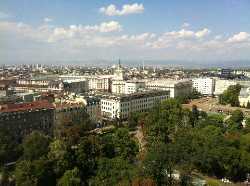
Sofia, the vibrant capital of Bulgaria, often surprises visitors with its rich tapestry of ancient history seamlessly interwoven with a burgeoning modern spirit. It wasn't always the sole center of power in the region; for centuries, other cities like Veliko Tarnovo held the esteemed title of capital during the Second Bulgarian Empire, a testament to the shifting dynamics of the Balkan Peninsula. Yet, Sofia's strategic location at the crossroads of ancient trade routes ultimately propelled it to its current prominence. Consider this: Sofia boasts the unique distinction of having a mineral spring flowing in the very heart of its city center. Located near the Serdica metro station and the Banya Bashi Mosque, this publicly accessible spring offers warm, slightly sulfuric water that locals and visitors alike can collect, a tangible link to the city's ancient thermal heritage. The presence of these springs even influenced the city's early development and its Roman name, Serdica, which was associated with thermal baths. Intriguingly, Sofia is home to a remarkably tolerant coexistence of different religions. Within a small radius in the city center, you can find the St. George Rotunda (an early Christian church), the Banya Bashi Mosque (an Ottoman-era mosque), the Sofia Synagogue (one of the largest Sephardic synagogues in Europe), and the St. Alexander Nevsky Cathedral (an impressive Orthodox cathedral). This peaceful proximity speaks volumes about the city's historical and contemporary embrace of diverse faiths. Another fascinating aspect of Sofia lies in its unexpected connection to the world of owls. The Little Owl is a common sight in the city's parks and even perched on its ancient ruins. So prevalent is this bird that it has become a somewhat unofficial symbol of Sofia's wisdom and longevity, often appearing in local art and folklore. Beyond its religious harmony and avian residents, Sofia holds a poignant claim to a rather unusual historical event. During World War II, the city was targeted by Allied bombing raids. However, the citizens of Sofia, demonstrating remarkable bravery and compassion, risked their own lives to rescue the Holy Relics of Saint John of Rila, Bulgaria's patron saint, from potential destruction, hiding them in various locations throughout the city. Furthermore, Sofia's metro system, while relatively modern compared to some other European capitals, was built upon the foundations of an earlier, unrealized tram project from the early 20th century. Some of the initial tunnel work was later incorporated into the current metro lines, a tangible link between past aspirations and present-day infrastructure. Finally, for those with an appreciation for Soviet-era monuments, Sofia offers a somewhat controversial yet undeniably imposing example: the Monument to the Soviet Army. While its presence remains a subject of ongoing debate and occasional artistic alterations, its sheer scale and central location serve as a powerful reminder of Bulgaria's complex 20th-century history and its past political affiliations. To explore Sofia is to encounter a city where ancient thermal waters flow freely, diverse faiths coexist peacefully, owls watch over ancient stones, and the layers of history, from Roman origins to socialist-era grandiosity, create a uniquely compelling urban tapestry.
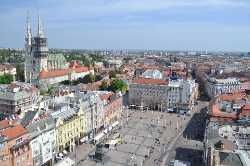
Zagreb, the captivating capital of Croatia, often surprises visitors with its charming blend of Austro-Hungarian elegance and a distinctly laid-back Balkan spirit. It wasn't always the undisputed heart of the region; for centuries, other cities like Varaždin held significant administrative and cultural sway within the Croatian lands, a testament to the shifting centers of power throughout its history. Yet, Zagreb's strategic location and eventual growth propelled it to its current prominence as the nation's vibrant hub. Consider this: Zagreb boasts a unique and charming tradition involving its Upper Town (Gornji Grad) and a cannon. Every day at noon, a cannon shot rings out from the Lotrščak Tower to commemorate a 16th-century legend. The story goes that a cannon shot from this tower precisely hit a Turkish pasha's tent across the Sava River, thwarting an imminent attack on the city. This daily booming reminder connects the modern city to a dramatic moment in its past. Intriguingly, Zagreb is home to a museum dedicated entirely to broken relationships. The Museum of Broken Relationships, located in the Upper Town, showcases personal objects and stories of failed loves, offering a poignant and often humorous exploration of human connection and loss. This unconventional museum has gained international acclaim for its unique and relatable concept, a testament to Zagreb's willingness to embrace the unusual. Another fascinating aspect of Zagreb lies in its surprisingly extensive network of tunnels beneath the Upper Town. Known as the Grič Tunnel, this underground system was originally built as a shelter during World War II and later served various purposes, including as a venue for raves in the 1990s. Today, it's a pedestrian walkway and occasionally hosts exhibitions and events, offering a cool and intriguing subterranean escape from the city's bustle. Beyond its unique museums and underground passages, Zagreb holds a charming tradition associated with its iconic blue trams. These trams, a familiar sight throughout the city, once included open-air carriages that were particularly popular in the summer months, allowing passengers to fully experience the city's sights and sounds. While these open-air trams are less common today, they evoke a nostalgic image of a more leisurely era in Zagreb's urban transport. Furthermore, Zagreb's main cemetery, Mirogoj, is not just a final resting place but also considered one of the most beautiful cemeteries in Europe. Designed by the renowned architect Hermann Bollé in the late 19th century, its impressive arcades, domes, and sculptures create a serene and architecturally significant space, often likened to an outdoor art gallery. Finally, for those with a sweet tooth, Zagreb offers a delightful local specialty: štrukli. This traditional pastry, made with cheese and either boiled or baked, comes in both sweet and savory variations and is a beloved comfort food throughout the region, representing a taste of Zagreb's culinary heritage. To explore Zagreb is to encounter a city where a daily cannon blast echoes a historic victory, a museum chronicles lost loves, underground tunnels whisper tales of the past, and a simple cheese pastry offers a comforting taste of local tradition.
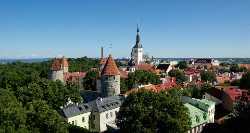
Tallinn, the enchanting capital of Estonia, often feels like stepping into a medieval fairytale with its remarkably preserved Old Town, a UNESCO World Heritage site. Yet, beneath its Hanseatic charm lies a history stretching back millennia, and a contemporary spirit that blends seamlessly with its ancient stones. It wasn't always the undisputed heart of Estonia; for periods under foreign rule, other centers held sway, a testament to the country's strategic location and shifting powers in the Baltic region. Yet, Tallinn's crucial port and defensive advantages ultimately solidified its role as the nation's enduring capital. Consider this: Tallinn's Town Hall Square (Raekoja plats) has served as a bustling marketplace and a focal point of city life since at least the 13th century. Remarkably, it still hosts various events and markets today, seamlessly connecting its medieval past with its vibrant present. Imagine strolling across the same cobblestones where merchants traded centuries ago, now perhaps browsing for local crafts or enjoying a festive atmosphere. Intriguingly, Tallinn boasts one of the oldest continuously operating pharmacies in Europe, the Town Hall Pharmacy (Raeapteek), which first opened its doors in 1422. Legends abound about the unusual remedies once sold there, including powdered unicorn horn and burnt hedgehogs, offering a fascinating glimpse into the medical beliefs and practices of the time. Today, it still functions as a pharmacy while also housing a small museum showcasing its intriguing history. Another fascinating aspect of Tallinn lies in its surprisingly extensive network of secret tunnels beneath the Old Town. These subterranean passages, some dating back to the medieval era, served various purposes over the centuries, from storage to providing shelter during wartime. Parts of these tunnels are now open to the public, offering a unique and slightly eerie perspective on the city's hidden depths and its strategic defenses. Beyond its medieval wonders, Tallinn holds a significant place in technological history. It was the birthplace of Skype, the groundbreaking video calling software that revolutionized global communication. This unexpected connection to modern technology underscores Estonia's forward-thinking spirit and its ability to blend its rich heritage with cutting-edge innovation. Furthermore, Tallinn's iconic Toompea Castle, perched atop a limestone hill overlooking the Old Town, has been a seat of power for centuries, serving as a stronghold for various rulers, from Danish and Swedish to German and Russian. Today, it houses the Estonian Parliament (Riigikogu), symbolizing the continuity of governance on this historically significant site. Finally, for those with a taste for local folklore, Tallinn has a charming legend associated with its "Vana Toomas" (Old Thomas) weather vane atop the Town Hall tower. This iconic figure, a symbol of the city since 1530, is said to have been inspired by a young boy who, despite being too small to participate in an archery contest, managed to shoot down a wooden parrot perched atop a pole, thus becoming the city's first "Old Thomas." To explore Tallinn is to encounter a city where medieval marketplaces thrive alongside modern technology, where ancient pharmacies whisper tales of bizarre remedies, and where a legendary weather vane continues to watch over a capital that seamlessly blends its captivating past with a dynamic present.
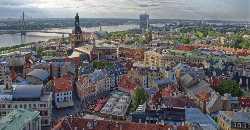
Riga, the vibrant capital of Latvia, gracefully straddling the Daugava River, offers a compelling narrative woven from its Hanseatic past, Art Nouveau splendor, and a resilient spirit forged through centuries of shifting geopolitical tides. It wasn't always the undisputed heart of the region; for periods under various foreign rules, other Baltic centers held significant influence, a testament to Latvia's strategic location and the ebb and flow of power in Northern Europe. Yet, Riga's crucial port and its burgeoning cultural scene ultimately cemented its role as the nation's dynamic hub. Consider this: Riga boasts one of the most impressive collections of Art Nouveau architecture in Europe, often considered second only to Brussels. This early 20th-century architectural style, characterized by its organic forms, intricate ornamentation, and mythological motifs, flourished in Riga, leaving behind a stunning legacy of elaborately decorated buildings that transform entire streets into open-air art galleries. Intriguingly, Riga's Old Town (Vecrīga), a UNESCO World Heritage site, is home to a unique tradition involving the Bremen Town Musicians, the beloved characters from the Grimm fairy tale. A sculpture depicting the donkey, dog, cat, and rooster standing atop one another can be found near St. Peter's Church. Rubbing the donkey's nose is said to bring good luck, a charming and whimsical addition to the city's historical landscape. Another fascinating aspect of Riga lies in its historical claim as the location where the very first Christmas tree was decorated in the early 16th century. According to historical accounts, members of the Blackheads' Brotherhood, a guild of unmarried merchants, adorned a tree with artificial roses, danced around it, and then burned it. This tradition, predating the widespread adoption of Christmas trees, marks Riga as a potential birthplace of a beloved holiday custom. Beyond its architectural and folkloric charms, Riga holds a significant place in cinematic history. The city served as a key filming location for the iconic Soviet-era Sherlock Holmes adaptations, particularly "The Adventures of Sherlock Holmes and Dr. Watson." Riga's atmospheric Old Town and its historic streets provided the perfect backdrop for recreating Victorian London, a testament to the city's timeless appeal and adaptable aesthetics. Furthermore, Riga's Central Market (Centrāltirgus), housed in five repurposed Zeppelin hangars from World War I, is one of the largest and most vibrant marketplaces in Europe. These massive pavilions offer a diverse array of goods, from fresh produce and local delicacies to clothing and household items, providing a bustling and authentic glimpse into everyday life in Riga. Finally, for those with a taste for local spirits, Riga is the birthplace of Black Balsam (Rīgas Melnais balzams), a traditional herbal liqueur with a complex and somewhat mysterious recipe dating back to the 18th century. This potent drink, often enjoyed neat, in cocktails, or even as a remedy, is a distinctly Latvian concoction and a cultural icon of the city. To explore Riga is to encounter a capital where Art Nouveau masterpieces line cobblestone streets, a fairy tale sculpture brings good fortune, the spirit of the first decorated Christmas tree lingers, and a historic market thrives within repurposed airship hangars, all contributing to its uniquely captivating character.

Pristina, the dynamic capital of Kosovo, stands as a testament to resilience and a youthful energy that belies its long and often turbulent history. It wasn't always the undisputed heart of the region; for centuries, other settlements held strategic importance within the historical lands of Dardania, a detail highlighting the shifting power dynamics of the Balkans. Yet, Pristina's central location and its eventual role as the administrative and cultural hub solidified its modern prominence. Consider this: Pristina is home to the Newborn monument, a striking typographic sculpture unveiled on the day Kosovo declared its independence in 2008. Initially painted bright yellow, it is repainted annually with themes reflecting the country's progress and aspirations, serving as a powerful and ever-evolving symbol of Kosovo's newfound sovereignty and its forward-looking spirit. This public artwork has quickly become an iconic landmark of the city. Intriguingly, Pristina boasts a vibrant and thriving cafe culture, with countless coffee shops lining its streets, often buzzing with young people and lively conversations. This deep-seated tradition reflects a strong social fabric and a central role for coffee houses as meeting places, discussion forums, and integral parts of daily life, reminiscent of other Balkan and Mediterranean cultures. Another fascinating aspect of Pristina lies in its surprisingly diverse architectural landscape, a visual representation of its layered history. Ottoman-era mosques and traditional houses stand alongside more modern structures, including the controversial National Library of Kosovo, a Brutalist design that has sparked both admiration and criticism for its unique and imposing form. This architectural mix offers a tangible glimpse into the various periods that have shaped the city's identity. Beyond its modern monuments and social scene, Pristina holds a significant historical connection to Mother Teresa. Born Anjezë Gonxhe Bojaxhiu in Skopje (now the capital of North Macedonia), her family had roots in Kosovo, and she spent a period of her early life in the region. Pristina Airport is named in her honor, a testament to the deep respect and pride Kosovo holds for this Nobel Peace Prize laureate. Furthermore, Pristina is home to the Ethnographic Museum, housed in a beautifully preserved 18th-century Ottoman-era complex. This museum offers a fascinating insight into the traditional life, customs, and crafts of Kosovo's various ethnic communities, providing a valuable window into the region's rich cultural heritage and its diverse influences. Finally, for those with an interest in contemporary art, Pristina has a burgeoning art scene, with numerous galleries and independent cultural spaces showcasing the work of young Kosovan artists. Despite the challenges the country has faced, a vibrant creative energy is palpable, reflecting a desire for expression and a dynamic engagement with the modern world. To explore Pristina is to encounter a city where a symbol of new beginnings is repainted annually, a strong cafe culture fuels social life, diverse architectural styles tell tales of the past, and the legacy of a global humanitarian is proudly embraced, all contributing to its unique and resilient character.
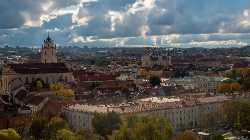
Vilnius, the enchanting capital of Lithuania, often feels like a city plucked from the pages of a storybook, its baroque architecture and cobblestone streets whispering tales of a rich and complex past. It wasn't always the undisputed heart of the Grand Duchy of Lithuania; for a time, Kaunas held significant importance, particularly during periods of conflict, a detail highlighting the shifting centers of power within this historically influential region. Yet, Vilnius's strategic location at the confluence of rivers and its burgeoning cultural and intellectual life ultimately cemented its role as the nation's enduring capital. Consider this: Vilnius boasts one of the largest and most well-preserved Old Towns in Eastern Europe, a UNESCO World Heritage site that seems to effortlessly blend architectural styles from Gothic to Baroque. Wandering its winding alleys and discovering hidden courtyards feels like stepping back in time, each corner revealing a new layer of history. Imagine strolling beneath the watchful gaze of centuries-old churches and the remnants of defensive walls. Intriguingly, Vilnius has a unique and somewhat whimsical tradition associated with its Užupis district. Declaring itself an independent republic on April Fools' Day in 1997, Užupis has its own constitution (translated into numerous languages and displayed on plaques), president, and even an army (of around twelve people). Crossing one of its bridges, marked with a sign proclaiming "Republic of Užupis," feels like entering a bohemian enclave where artistic freedom and a playful spirit reign supreme. Another fascinating aspect of Vilnius lies in its historical connection to a surprisingly fragrant profession: glove-making. In the 16th and 17th centuries, Vilnius was renowned for its high-quality leather gloves, a craft that brought considerable wealth and prestige to the city. While this industry has largely faded, its legacy can still be found in some street names and historical records, a subtle reminder of a less-known aspect of Vilnius's economic past. Beyond its architectural charm and artistic enclaves, Vilnius holds a significant place in literary history. It was home to the Vilnius Gaon, a renowned 18th-century Jewish scholar who became one of the most influential figures in Rabbinic Judaism. His intellectual legacy continues to draw scholars and visitors to Vilnius, highlighting the city's historical importance as a center of learning and religious thought, often referred to as the "Jerusalem of Lithuania." Furthermore, Vilnius University, founded in 1579, is one of the oldest and most distinguished universities in Eastern Europe. Its historic campus, with its numerous courtyards and architectural gems, has been a center of intellectual and cultural life for centuries, shaping the minds of countless influential figures in Lithuanian history and beyond. Finally, for those with a taste for the mystical, Vilnius is said to be located on a powerful energetic point, with various ley lines intersecting beneath the city. While not scientifically proven, this belief adds a certain mystique to the atmosphere of Vilnius, contributing to its often-described enchanting and spiritual feel. To explore Vilnius is to encounter a city where medieval grandeur meets bohemian independence, where the scent of ancient crafts lingers in historical records, and where a long tradition of learning and a touch of the mystical create a uniquely captivating and memorable experience.
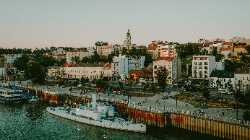
Belgrade, the spirited capital of Serbia, stands at the strategic confluence of the Sava and Danube rivers, a location that has shaped its turbulent yet fascinating history for millennia. It wasn't always the undisputed heart of the region; for periods under various empires, other centers held sway, a testament to the Balkans' complex and ever-shifting power dynamics. Yet, Belgrade's pivotal position as a gateway between East and West ultimately cemented its role as the nation's enduring and resilient capital. Consider this: Belgrade is one of the oldest continuously inhabited cities in Europe, with archaeological evidence of settlements dating back to the Neolithic period. The Celtic tribe of Scordisci later founded Singidunum in the 3rd century BC, which the Romans then transformed into a significant military stronghold. This deep historical lineage lies beneath the modern city, a silent testament to countless generations who have called this strategic location home. Intriguingly, Belgrade has been razed to the ground and rebuilt over 40 times throughout its long and often violent history. This remarkable cycle of destruction and rebirth has earned it the poignant moniker of the "White Phoenix," symbolizing its enduring ability to rise from the ashes and reinvent itself. Each layer of its urban fabric bears the marks of different empires and conflicts, creating a unique and resilient cityscape. Another fascinating aspect of Belgrade lies in its surprising abundance of green spaces. Despite being a bustling capital, it boasts numerous parks, including the expansive Kalemegdan Fortress Park, offering breathtaking views of the river confluence and housing historical monuments, museums, and even a zoo. This dedication to green lungs within the urban environment provides a welcome respite and underscores the city's connection to its natural surroundings. Beyond its historical resilience and green spaces, Belgrade holds a unique claim as the location of one of the world's largest Orthodox Christian churches, the Church of Saint Sava. Its monumental scale and stunning Byzantine-inspired architecture dominate the city's skyline, a powerful symbol of SerbianOrthodoxy and a testament to the nation's deep religious traditions. Construction of this grand structure spanned much of the 20th century and continues in some aspects today, reflecting its significance to the Serbian people. Furthermore, Belgrade is home to Skadarlija, a bohemian quarter often compared to Montmartre in Paris. This charming cobblestone street, lined with traditional restaurants, cafes, and art galleries, was once a gathering place for artists, writers, and poets in the late 19th and early 20th centuries, retaining a vibrant and artistic atmosphere that attracts both locals and tourists seeking a taste of old Belgrade. Finally, for those with an appreciation for unusual landmarks, Belgrade features the "Genex Tower" or "Western City Gate," a striking Brutalist skyscraper with a rotating restaurant at its summit. While currently not operational, its distinctive and somewhat imposing design has become an iconic, albeit controversial, part of the city's modern skyline, a testament to a particular architectural era and a reminder of Belgrade's diverse urban landscape. To explore Belgrade is to encounter a city where ancient foundations lie beneath layers of turbulent history, a place that has repeatedly risen from destruction, embraces its green spaces, and proudly displays both its grand religious symbols and its bohemian artistic soul.

Vaduz, the serene capital of the Principality of Liechtenstein, often surprises visitors with its intimate scale and the captivating blend of its regal heritage nestled amidst stunning Alpine scenery. It wasn't always the obvious center of this tiny nation; for a time, Schellenberg held more administrative importance, a detail reflecting the gradual consolidation of Liechtenstein's territories. Yet, Vaduz's strategic location beneath its imposing castle ultimately cemented its role as the principality's enduring heart. Consider this: Vaduz Castle, the iconic landmark perched dramatically on a steep cliff overlooking the town, is not just a picturesque backdrop; it has been the residence of the Princely Family of Liechtenstein since the early 20th century. Unlike many European castles open to the public, Vaduz Castle remains a private home, lending an air of authentic, lived-in royalty to the capital. The Princely Family's continued presence underscores the close-knit relationship between the monarchy and the nation. Intriguingly, despite its small size, Vaduz boasts a surprisingly significant collection of art. The Kunstmuseum Liechtenstein houses an impressive array of modern and contemporary art, attracting international exhibitions and showcasing the principality's commitment to culture beyond its stunning landscapes. This modern cultural institution provides an unexpected contrast to the traditional charm of the town. Another fascinating aspect of Vaduz lies in its unique postal history. Liechtenstein issues its own highly sought-after postage stamps, renowned for their intricate designs and often thematic connections to the principality's history, art, and natural beauty. Philately is a significant aspect of Liechtenstein's cultural identity, and the postal museum in Vaduz offers a captivating glimpse into this miniature world of artistry and history. Beyond its castle, art, and stamps, Vaduz holds a direct connection to a surprisingly global tradition: the pedestrian crossing signal. The "Ampelmännchen," the charming little green and red men found on pedestrian traffic lights in former East Germany, were designed by Karl Peglau. Interestingly, Peglau later moved to Liechtenstein and even created a Vaduz-specific "Ampelmännchen" featuring a figure wearing a traditional hat, a whimsical nod to the principality's cultural identity. Furthermore, despite being a landlocked country, Liechtenstein has a naval register. This seemingly paradoxical situation arose due to international shipping regulations and offers certain financial advantages. While you won't see large ships docked in Vaduz, the principality's flag can be found on vessels navigating the world's oceans, a quirky example of its engagement with the global economy. Finally, for those with a taste for the local tipple, Vaduz is surrounded by vineyards producing surprisingly high-quality wines. The mild climate and fertile soil of the Rhine Valley contribute to a burgeoning wine industry, and local Weinstuben (wine taverns) offer the opportunity to sample these regional varieties, providing a delicious and authentic taste of Liechtenstein's terroir. To explore Vaduz is to encounter a capital where a private royal residence overlooks a vibrant art museum, where a philatelic tradition thrives, a charming pedestrian signal adds local flair, and a landlocked nation boasts a naval fleet, all nestled amidst breathtaking Alpine scenery and surprisingly good vineyards.
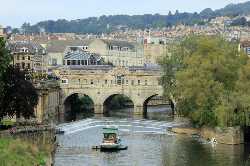
Bath, the elegant city nestled in the rolling hills of Somerset, England, whispers tales of Roman sophistication and Georgian grandeur from its honey-colored stone streets. It wasn't always a fashionable spa town; its origins lie much deeper, rooted in the thermal springs that gave the city its very name. Legend attributes the discovery of these healing waters to the mythical Prince Bladud, father of King Lear, who supposedly cured his leprosy by bathing in the warm mud, a foundational myth that imbues the city with an ancient, almost magical quality. Consider this: Bath is the only entire city in the United Kingdom to be designated a UNESCO World Heritage Site. This prestigious recognition acknowledges its exceptional universal value due to its unique concentration of significant archaeological remains, Georgian architecture, and the natural hot springs that have attracted visitors for millennia. To wander through its perfectly preserved crescents and terraces is to step into a living museum of architectural history. Intriguingly, the Roman Baths, the city's namesake and a remarkably preserved ancient complex, were once much more than just bathing facilities. They were a social hub, a place for relaxation, worship, and even business transactions. The elaborate temple dedicated to the goddess Sulis Minerva highlights the spiritual significance of the springs to the Roman inhabitants, demonstrating a sophisticated understanding of both physical and spiritual well-being. Another fascinating aspect of Bath lies in its connection to the celebrated author Jane Austen. She lived in Bath for several years, and the city served as the backdrop for two of her novels, "Northanger Abbey" and "Persuasion." Walking the same streets that Austen herself would have strolled offers a tangible link to her literary world, and the Jane Austen Centre provides a delightful insight into her life and times in this fashionable Georgian spa town. Beyond its Roman and literary heritage, Bath boasts a unique architectural marvel: the Royal Crescent. This sweeping arc of thirty terraced houses, designed by John Wood the Younger, is considered one of the finest examples of Georgian architecture in the UK. Its perfectly symmetrical facade and harmonious proportions evoke a sense of classical elegance and grandeur, a testament to the sophisticated design principles of the era. Furthermore, Bath is home to Pulteney Bridge, one of only four bridges in the world to have shops built across its full span. Designed by Robert Adam, this elegant structure not only provides a vital crossing over the River Avon but also functions as a unique shopping street, seamlessly blending infrastructure with commerce in a visually striking way. Finally, for those with an appreciation for astronomy, William Herschel, the astronomer who discovered the planet Uranus, lived and worked in Bath. The Herschel Museum of Astronomy, located in his former home, commemorates his groundbreaking discoveries made while residing in the city, adding a celestial dimension to Bath's rich tapestry of history and innovation. To explore Bath is to encounter a city where ancient Roman rituals met Georgian elegance, where literary giants found inspiration, and where architectural marvels and astronomical breakthroughs contribute to its enduring and captivating allure.
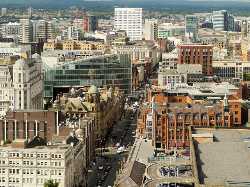
Manchester, a city that thrums with a pioneering spirit and a distinctive swagger, often surprises visitors with its depth of history and its enduring influence far beyond the football pitches. It wasn't always the industrial powerhouse it became; its origins lie in a Roman fort named Mamucium, a strategic outpost that hints at its long-standing importance as a settlement and a point of connection. This Roman foundation quietly underpins the city's later dynamism. Consider this: Manchester was the world's first industrial city. The rapid growth of cotton mills and factories during the 18th and 19th centuries transformed it from a market town into a global center for manufacturing and trade, forever altering the social and economic landscape of Britain and the world. The remnants of this industrial heritage, from the grand warehouses to the canals that once teemed with barges, are still visible throughout the city, a tangible link to its revolutionary past. Intriguingly, Manchester boasts a rich musical heritage that has profoundly influenced popular culture. From the groundbreaking sounds of the Smiths and Joy Division to the "Madchester" scene of the late 1980s and early 1990s with bands like the Stone Roses and Happy Mondays, the city has consistently produced innovative and influential music genres, earning it a reputation as a global music capital. The echoes of these iconic sounds still resonate in its vibrant venues and creative spirit. Another fascinating aspect of Manchester lies in its pivotal role in the development of computer science. The "Manchester Baby," the world's first stored-program computer, was built at the University of Manchester in 1948. This groundbreaking invention laid the foundation for modern computing and solidified the city's place at the forefront of technological innovation, a legacy that continues with its thriving digital and tech industries today. Beyond its industrial, musical, and scientific contributions, Manchester holds a unique claim as the birthplace of the vegetarian movement in the UK. The Vegetarian Society was founded in Manchester in 1847, reflecting a long-standing tradition of alternative thinking and social reform within the city. This historical detail highlights a perhaps unexpected aspect of Manchester's progressive history. Furthermore, Manchester is home to the oldest surviving public library in the English-speaking world, Chetham's Library, which was founded in 1653. This magnificent library, with its original fittings and extensive collection of rare books and manuscripts, offers a tangible connection to centuries of learning and intellectual pursuit, a quiet sanctuary amidst the bustling modern city. Finally, for those with a penchant for the unconventional, Manchester boasts a unique tradition of naming its canal boats after famous figures, often with a humorous or local connection. Exploring the city's waterways can reveal boats named after musicians, politicians, and even local characters, adding a touch of quirky charm to its industrial arteries. To explore Manchester is to encounter a city where the echoes of the Industrial Revolution meet the sounds of groundbreaking music, where the foundations of modern computing were laid, and where a progressive spirit has long thrived, all contributing to its distinctive and enduring character.
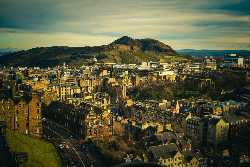
Edinburgh is not just Scotland’s capital; it is a city that feels alive with history, a place where every skyline tells a story and every cobbled street holds a secret. Visitors often say it feels like stepping into another world, where the past and present exist side by side. The story of Edinburgh begins with fire and stone. The dramatic landscape was formed millions of years ago by volcanic activity, leaving behind the crags and peaks that now define the city. Rising above it all is Arthur’s Seat, the great green hill beloved by walkers, and the mighty Castle Rock, crowned by Edinburgh Castle. Few fortresses in Europe have seen as much drama: royal births, sieges, and battles that decided the fate of Scotland. The Scottish Crown Jewels and the Stone of Destiny, once used in the coronation of kings, are still kept within its walls. To stand on the castle ramparts is to stand where monarchs, warriors, and poets once stood, gazing out over the same sweeping views of the city. From the castle gates, the famous Royal Mile spills downhill toward the Palace of Holyroodhouse. This ancient street is the backbone of Edinburgh’s Old Town, and walking along it is like travelling through centuries. Once bustling with merchants, beggars, and nobles, it was also a place of hardship—plague swept through the cramped closes, and public executions drew crowds. Today it is alive with street performers, whisky shops, museums, and storytellers who keep its colourful past alive. Along the way stands St. Giles’ Cathedral, a landmark of Scottish faith and politics for over 900 years. If the Old Town speaks of medieval grit, the New Town, built in the 18th century, shows another side of Edinburgh. At that time the city became known as the “Athens of the North” thanks to its role in the Scottish Enlightenment. Great thinkers like David Hume and Adam Smith lived and worked here, while elegant Georgian squares and crescents were built in graceful order. To wander from the shadowy closes of the Old Town into the symmetry of the New Town is to see two different worlds existing within a single city. But Edinburgh is not all about kings and philosophers—it is also a city of myths and legends. Greyfriars Kirkyard is said to be one of the most haunted graveyards in the world, and the underground vaults beneath the Old Town are filled with ghostly tales. Yet the city’s most touching story is one of loyalty: that of Greyfriars Bobby, the little dog who famously guarded his master’s grave for 14 years. His statue outside the kirkyard remains one of the most photographed spots in the city. Today, Edinburgh is as much about celebration as it is about history. Every August, it becomes the stage for the Edinburgh Festival Fringe, the world’s largest arts festival, where comedians, actors, musicians, and artists transform the city into a carnival of creativity. At night, the sky above the Castle glows with fireworks during the Royal Edinburgh Military Tattoo, a spectacle of music and pageantry that draws audiences from across the world. What makes Edinburgh so captivating is the way its past and present blend seamlessly. Ancient fortresses share the skyline with modern theatres, ghost stories are told beside lively pubs, and scholarly history meets artistic energy. Climb Arthur’s Seat for a view across the rooftops, wander the Royal Mile to feel its pulse, explore the New Town’s elegance, or lose yourself in stories that have shaped this city for over a thousand years.
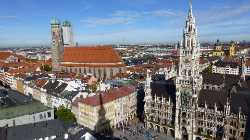
Munich, the capital of Bavaria, is one of Europe’s most captivating cities, where centuries of history blend seamlessly with modern vibrancy. Nestled on the banks of the River Isar and framed by the distant Bavarian Alps, Munich is far more than just the gateway to Oktoberfest. It is a city of grand squares, ornate palaces, leafy parks, and a welcoming culture that charms visitors from around the world. The city’s story begins in 1158, when it was officially founded by Henry the Lion, Duke of Saxony and Bavaria. Its name, derived from “Munichen,” meaning “by the monks,” reflects its origins near a Benedictine monastery. By the 14th century it had become a flourishing center of trade, and under the Wittelsbach dynasty it developed into a city of art and science. Splendid baroque churches, Rococo theaters, and neoclassical boulevards gave it an elegant appearance that still endures. Although Munich suffered heavy bombing during the Second World War, much of its historic core was painstakingly rebuilt, so today a walk through the Altstadt still feels like a journey into the past, with medieval gates, Renaissance courtyards, and the twin Gothic towers of the Frauenkirche shaping the skyline. Visitors are quickly struck by the city’s architectural beauty: the Neues Rathaus on Marienplatz with its famous Glockenspiel, the vast Residenz once home to Bavarian monarchs, and the baroque Nymphenburg Palace with its sweeping gardens. Culture thrives here as well. The Pinakotheken museums display treasures from Dürer and Rubens to Van Gogh and Picasso, while the Deutsches Museum, the world’s largest museum of science and technology, fascinates visitors of all ages. Music and performance also play a vital role, with the Bavarian State Opera continuing a long tradition of excellence. Munich is equally celebrated for its traditions and festivals. The world’s largest folk festival, Oktoberfest, draws millions every autumn to the Theresienwiese, but Bavarian hospitality can be found year-round in countless beer gardens. Legendary spots such as the Hofbräuhaus or the leafy Augustiner-Keller invite guests to share long tables, enjoy hearty food, and raise a stein of locally brewed beer. Despite its urban character, Munich is a remarkably green city. The English Garden, larger even than New York’s Central Park, offers space for strolls, picnics, and even surfing on the Eisbach wave, while riverside paths along the Isar are beloved by walkers and cyclists. Munich also serves as a gateway to the Bavarian Alps, with fairy-tale castles like Neuschwanstein, serene alpine lakes, and winter ski resorts all within easy reach. What makes Munich so distinctive is the way it combines tradition and innovation. It is a place where one can sip beer under chestnut trees in the afternoon and attend a cutting-edge art exhibition in the evening. Locals embody the idea of “Gemütlichkeit,” a uniquely German sense of warmth, friendliness, and enjoyment of life’s simple pleasures. For travelers, Munich is a city that offers something for everyone: history, art, nature, festivals, and a spirit that lingers long after the visit. More than the cultural heart of Bavaria, it is a city where past and present embrace, inviting every guest to discover their own story in this remarkable place.
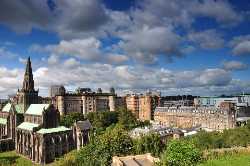
Glasgow, Scotland’s largest city, is a place of energy, creativity, and warmth that has transformed itself from an industrial powerhouse into one of Europe’s most vibrant cultural destinations. Situated on the River Clyde, the city grew rapidly during the 18th and 19th centuries as a centre of shipbuilding, trade, and engineering, earning a reputation as the “Second City of the Empire.” While its industrial heritage is still visible in grand Victorian architecture and dockside warehouses, Glasgow today is better known for its thriving arts scene, lively streets, and welcoming character. Its history stretches back to medieval times, when St. Mungo founded a religious settlement here in the 6th century. Glasgow Cathedral, a striking medieval building that still dominates the city, stands as a reminder of those early days. Over the centuries the city expanded with the growth of trade, especially tobacco and textiles, and by the 19th century it had become a wealthy and cosmopolitan hub. The industrial decline of the 20th century hit hard, but Glasgow reinvented itself, investing in culture, education, and tourism, and in 1990 it was named European City of Culture, a title that marked the beginning of its renaissance. Today, Glasgow offers visitors an impressive mix of attractions. Architecture lovers are drawn to the works of Charles Rennie Mackintosh, the city’s most famous designer, whose legacy can be admired at the Willow Tea Rooms, the Lighthouse, and the Mackintosh House. The city centre is lined with grand Victorian buildings, George Square is a showcase of civic pride, and the University of Glasgow, founded in 1451, enchants visitors with its Gothic spires and cloisters. For those who enjoy shopping and urban life, Buchanan Street and the “Style Mile” are filled with shops, cafés, and street performers, creating one of the UK’s liveliest pedestrian zones. Glasgow is also celebrated for its green spaces. The city boasts over 90 parks and gardens, including the Kelvingrove Park, home to the much-loved Kelvingrove Art Gallery and Museum, and Glasgow Green, one of the oldest public parks in Scotland. Along the Clyde, modern developments have reshaped the waterfront with attractions like the SEC Centre and the Clyde Auditorium, known as “the Armadillo.” The striking Riverside Museum, designed by Zaha Hadid, tells the story of transport and innovation, linking Glasgow’s industrial past to its creative present. Music is at the heart of Glasgow’s identity. Named a UNESCO City of Music, it offers everything from classical performances by the Royal Scottish National Orchestra to contemporary gigs at the Barrowland Ballroom, King Tut’s Wah Wah Hut, and the OVO Hydro, one of the world’s busiest arenas. Festivals such as Celtic Connections bring international artists to the city, while traditional pubs often host live folk sessions. This passion for music mirrors the lively spirit of Glaswegians themselves, who are known for their humour, friendliness, and down-to-earth approach that makes every visitor feel welcome. Food and drink add another dimension to the experience. From traditional pubs serving hearty Scottish fare to modern restaurants and a growing street food scene, Glasgow caters to all tastes. The West End, with its bohemian cafés and bars, is particularly popular with students and visitors alike, while the Merchant City offers chic dining in historic surroundings.
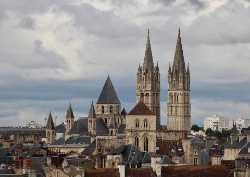
Caen, the historic capital of Normandy, is a city that seamlessly blends medieval charm, wartime heritage, and vibrant modern life. Located just a short distance from the English Channel, Caen is often overlooked in favor of Paris or the D-Day beaches, yet it offers visitors a wealth of fascinating experiences. The city owes much of its fame to William the Conqueror, who made Caen one of his principal residences in the 11th century. He and his wife, Queen Matilda, founded the Abbaye aux Hommes (Men’s Abbey) and Abbaye aux Dames (Women’s Abbey), two stunning Romanesque monasteries that still dominate the cityscape. Alongside them stands the Château de Caen, one of the largest medieval fortresses in Europe, offering sweeping views of the old town and housing the Museum of Normandy and the Fine Arts Museum. These monuments provide a powerful glimpse into the city’s medieval glory. But Caen’s history is not only medieval. The city suffered heavy bombing during the Battle of Normandy in 1944, leaving scars that are still visible today. From this destruction, however, rose one of the city’s most moving landmarks: the Caen Memorial Museum. Dedicated to peace, the museum explores World War II, the Cold War, and the pursuit of reconciliation, making it one of the most thought-provoking attractions in France. Beyond history, Caen charms with its picturesque streets lined with half-timbered houses, lively squares, and the scenic marina on the River Orne. The bustling Vaugueux district, once a medieval quarter, now thrives with restaurants and cafés perfect for sampling Norman specialties such as cider, Camembert, and fresh seafood. What makes Caen truly fascinating is its dual identity: a city of conquerors and abbeys, but also a symbol of resilience and rebirth. Few places in France capture both the grandeur of the Middle Ages and the lessons of modern history so vividly. For travelers seeking culture, reflection, and authentic French atmosphere, Caen is an unforgettable destination.
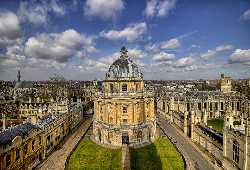
Oxford, often called the “City of Dreaming Spires,” is one of England’s most fascinating destinations, blending centuries of history with a vibrant cultural life. Best known for the University of Oxford, the oldest in the English-speaking world, the city attracts visitors eager to explore its historic colleges, cobbled streets, and leafy riverside paths. Each college has its own character, from the medieval grandeur of Christ Church to the quiet charm of Magdalen, complete with deer park and tower. A stroll through Radcliffe Square reveals the iconic Radcliffe Camera, Bodleian Library, and University Church of St Mary the Virgin, a cluster that embodies the intellectual heart of Oxford. Beyond its academic treasures, Oxford offers a wealth of museums. The Ashmolean, Britain’s oldest public museum, houses art and antiquities from across the globe. The Pitt Rivers Museum delights with its eccentric displays of anthropology, while the nearby Museum of Natural History impresses with dinosaur skeletons and a striking glass roof. For something more intimate, the Museum of Oxford inside Town Hall traces the city’s civic story, while the History of Science Museum holds Galileo’s telescope and other wonders. Oxford is also a city of green spaces. The University Parks, Christ Church Meadow, and Botanic Garden invite leisurely walks, punting on the River Cherwell remains a timeless tradition, and Port Meadow offers vast pastoral views little changed since ancient times. The Covered Market in the city centre provides a taste of local life, with food stalls, cafés, and traditional shops. Culturally, Oxford thrives with theatres such as the Sheldonian and New Theatre, while Modern Art Oxford brings contemporary contrast. The city’s literary associations run deep: Lewis Carroll, J. R. R. Tolkien, and C. S. Lewis all drew inspiration here. With its blend of scholarship, history, and charm, Oxford is a place where past and present harmoniously meet, rewarding every curious traveller with beauty, knowledge, and unforgettable atmosphere.
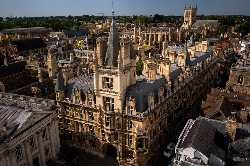
Cambridge is one of England’s most charming destinations, a place where centuries of academic tradition meet a lively modern atmosphere. Best known for its world-famous university, founded back in 1209, the city draws visitors from across the globe who come to admire its history, architecture, and riverside beauty. The colleges, with their peaceful courtyards, chapels, and libraries, sit at the heart of Cambridge life. Among them, King’s College Chapel stands out with its spectacular fan-vaulted ceiling and stained glass windows, a true masterpiece of Gothic design and one of Britain’s most iconic landmarks. A visit to Cambridge often starts by the River Cam. Punting here isn’t just a way to get around—it’s part of the city’s identity. Drifting past the “Backs,” where the grand façades of the colleges open onto carefully kept gardens, gives you a view of Cambridge that feels timeless. Away from the river, cobbled streets lead you to lively markets, old pubs, and quirky bookshops that keep the city’s scholarly spirit alive. There’s also plenty to see beyond the colleges. The Fitzwilliam Museum showcases everything from Renaissance paintings to ancient artefacts, while the Museum of Archaeology and Anthropology reveals treasures from across the world. Science lovers won’t want to miss Cambridge’s legacy of discovery at the Cavendish Laboratory, while today the city plays a key role in the “Silicon Fen,” the UK’s answer to Silicon Valley. For a slower pace, the Cambridge University Botanic Garden is a wonderful spot to wander, with 40 acres of plants, glasshouses, and peaceful paths. If you prefer cycling, the city is perfect for it—routes take you into nearby countryside, including the lovely Grantchester Meadows, a favourite retreat of poets and writers. What makes Cambridge so special is how it balances past and present. You might see a Nobel Prize winner walking the same streets as students rushing to class, all against a backdrop of medieval chapels and historic bridges. Whether you come for the history, the culture, or simply the riverside charm, Cambridge has a way of leaving a lasting impression.
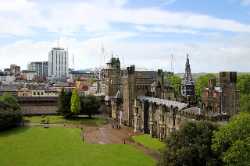
Cardiff, the vibrant capital of Wales, is a city where ancient history and modern life blend seamlessly. Once a small town, Cardiff grew rapidly during the 19th century thanks to its docks, which became a vital hub for exporting coal from the Welsh valleys. Today, it stands as a lively cultural, political, and sporting center, attracting millions of visitors each year. One of Cardiff’s most striking landmarks is Cardiff Castle, a fortress with Roman origins that was later transformed into a lavish Gothic Revival mansion. Within its walls, visitors can wander through medieval chambers, climb the Norman keep for panoramic views, and admire the eccentric interiors designed by architect William Burges. Not far away, the grand Civic Centre and National Museum Cardiff highlight the city’s cultural and educational importance. Cardiff also boasts a strong sporting reputation. The Principality Stadium, right in the city center, is home to Welsh rugby and has hosted everything from international matches to major concerts. On match days, the streets come alive with music, color, and an infectious sense of national pride. For those who enjoy the outdoors, Bute Park, one of the UK’s largest urban parks, offers a peaceful escape with riverside walks, woodlands, and gardens just steps away from the bustling city. Meanwhile, Cardiff Bay represents the city’s modern face. Once an industrial dockland, it has been transformed into a waterfront leisure and cultural district, featuring the striking Wales Millennium Centre, a landmark of Welsh performing arts. The city is also known for its shopping and dining. St David’s Shopping Centre provides a modern retail experience, while the historic Victorian arcades are filled with independent boutiques, cafés, and quirky shops that give Cardiff its unique character. Food lovers can sample Welsh specialties like bara brith and Welsh rarebit alongside an array of international cuisine. Cardiff is a gateway to wider South Wales as well. Within a short journey, visitors can reach the Brecon Beacons National Park, the Vale of Glamorgan coast, or the heritage sites of the Welsh valleys. Compact yet dynamic, Cardiff offers something for everyone—history, culture, nature, and sport—making it an unforgettable destination for any traveler exploring Wales.
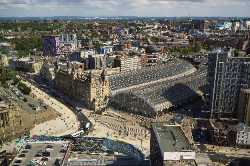
Liverpool, a vibrant and resilient city on England’s northwest coast, feels like a place that has been shaped by the sea and a spirit of fierce independence. It's a city where history and a forward-looking energy coexist, creating a unique and welcoming atmosphere. When you arrive, the first thing that grabs you is the UNESCO-listed waterfront. The Royal Albert Dock, once a bustling hub for trade, is now a beautiful maze of red-brick warehouses housing world-class museums, trendy shops, and fantastic places to eat. Here, you can immerse yourself in The Beatles' story, explore the Merseyside Maritime Museum, or discover modern art at Tate Liverpool. And as you look across the water, the iconic "Three Graces"—the Royal Liver Building, the Cunard Building, and the Port of Liverpool Building—stand tall, a proud reminder of the city's rich seafaring past. But Liverpool's charm extends far beyond its docks. Take a walk through the city, and you'll find a captivating blend of old and new. The two cathedrals alone are a sight to behold: the massive Anglican Liverpool Cathedral, which offers breathtaking city views from its tower, and the strikingly modern Metropolitan Cathedral, a marvel of 20th-century design. This mix of grand Victorian architecture and bold, contemporary structures tells the story of a city that constantly reinvents itself. And of course, you can't talk about Liverpool without mentioning football. A trip to Anfield, the legendary home of Liverpool Football Club, is more than just a match—it's an experience. The sound of thousands of fans singing "You'll Never Walk Alone" is unforgettable. Just a short trip across the park is Goodison Park, adding to the city’s deep-rooted passion for the sport. Ultimately, what makes Liverpool truly special is its people. The famous Scouse wit and warmth fill the streets, making you feel instantly at home. From catching a live gig at the legendary Cavern Club to exploring lively markets and enjoying the city's fantastic food scene, Liverpool is a place that leaves a lasting and unforgettable impression on everyone who visits.
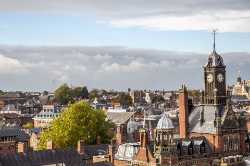
York, in the heart of North Yorkshire, is one of England’s most captivating cities, where every street and stone tells a story. Founded by the Romans in 71 AD as Eboracum, later ruled by the Vikings as Jorvik, and shaped through the medieval era, York has grown into a place where the past and present blend seamlessly. The most iconic landmark is York Minster, one of the largest Gothic cathedrals in Europe. Its towering spires, intricate stained glass, and medieval stonework make it a masterpiece of architecture and faith. From the Central Tower, visitors enjoy sweeping views across the red-roofed city and the surrounding countryside. Wandering through York’s narrow, winding streets is like stepping back in time. The Shambles, with its overhanging timber-framed houses, is one of the best-preserved medieval shopping streets in the world. Today, it is filled with independent shops, cafés, and sweet boutiques, but its crooked charm remains unchanged. York is also a city of stories. The Jorvik Viking Centre recreates the sights, sounds, and even smells of Viking York, while the York Castle Museum brings different eras of history vividly to life. The National Railway Museum celebrates Britain’s proud rail heritage, with engines ranging from the Flying Scotsman to sleek modern locomotives. Surrounded by medieval city walls, York offers the chance for a leisurely walk that circles the old centre, giving new perspectives of its gates, towers, and hidden gardens. Beyond the walls, peaceful riverside paths along the Ouse invite quiet moments, while lively pubs and tea rooms keep the city full of character. York is also a cultural hub. Theatres, art galleries, and festivals run throughout the year, from ghost walks to Christmas markets, making it a destination that feels alive in every season. With its mix of history, charm, and warm Yorkshire hospitality, York is not just a place to visit—it’s a place to experience and remember.
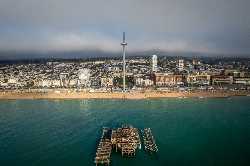
Brighton, often called “London by the Sea”, is one of England’s most vibrant and colorful coastal cities. Sitting on the south coast just an hour from London by train, it has long been a favorite escape for day-trippers, holidaymakers, artists, and free spirits. With its pebbled beaches, historic pier, royal palace, and lively streets, Brighton offers a mix of seaside charm and cosmopolitan energy that’s hard to resist. At the heart of the city is the seafront, where locals and visitors gather to enjoy fresh sea air and sweeping views across the English Channel. The Brighton Palace Pier, with its arcades, fairground rides, and candyfloss stalls, is the city’s most famous landmark and a nostalgic reminder of traditional British seaside fun. A walk along the pier at sunset, when the lights flicker on, is a must-do experience. Equally striking is the Royal Pavilion, an exotic palace built for King George IV in the 19th century. With its onion domes, minarets, and lavish interiors, it looks more like something from India or Arabia than an English resort town. Today, it’s open to visitors and stands as one of the most unique royal residences in Britain. For shopping and exploring, Brighton’s The Lanes are a delight. This maze of narrow streets is filled with quirky boutiques, antique shops, jewelers, and independent cafés. The nearby North Laine area has a more bohemian vibe, with vintage stores, street art, and lively markets that showcase Brighton’s creative spirit. Street performers and musicians often add to the atmosphere, making a stroll here an experience in itself. Brighton is also famous for its inclusive and open-minded culture. It has one of the UK’s most celebrated Pride festivals, drawing crowds from around the world every summer. The city’s nightlife is equally legendary, with a mix of traditional pubs, trendy cocktail bars, and clubs that keep the party going until dawn. Nature lovers won’t be disappointed either. Just outside the city lies the stunning South Downs National Park, where rolling hills, chalk cliffs, and countryside trails offer a peaceful contrast to the busy seafront. A short trip away are the iconic Seven Sisters cliffs, one of the most photographed coastal landscapes in England. Whether you’re visiting for a weekend or a longer stay, Brighton never fails to impress. It’s a city that blends history and modernity, seaside relaxation and cultural excitement. From its royal palace and pier to its buzzing markets and creative scene, Brighton truly has something for everyone – a seaside destination with a personality as colorful as its sunsets.
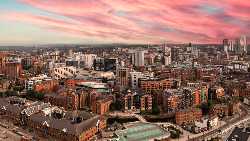
Leeds is one of those cities that grabs you and doesn’t let go. It has a palpable energy that comes from a long history of industry and a bold, forward-looking spirit. It’s a place that’s always reinventing itself, a city that wears its past on its sleeve while sprinting toward the future. You can feel it in the air—the buzz of a thriving metropolis with the soul of a friendly northern town. The city’s story is etched into its very foundations. Look up at the magnificent Victorian buildings and grand industrial warehouses, and you’ll see the legacy of its textile and manufacturing past. But what makes Leeds so special is how it has brought these old bones back to life. The beautiful Victorian arcades, once bustling with trade, now house independent boutiques, trendy cafes, and unique shops, creating a magical, covered streetscape that feels worlds away from the high street. The old industrial mills have been transformed into chic apartments, creative studios, and vibrant food halls, blending history with contemporary style. Beyond its architecture, Leeds is a city of creative pulse. From the music venues that have launched some of the UK’s biggest bands to the thriving independent food scene, there’s always something new to discover. The city’s markets, particularly Kirkgate Market, are a feast for the senses, overflowing with local produce, artisanal goods, and the genuine warmth and wit of the people who call Leeds home. This is where you experience the famous Yorkshire friendliness firsthand—a down-to-earth charm that makes every visitor feel welcome. And while Leeds is a major urban center, it is blessed with a surprising amount of green space. You can easily escape the hustle and bustle in Roundhay Park, one of the largest city parks in Europe, or take a short trip to the stunning scenery of the Yorkshire Dales National Park. The proximity to nature gives the city a refreshing balance, allowing residents and visitors alike to enjoy the best of both worlds. In essence, Leeds is a city that never stands still. It is a place of endless curiosity and constant evolution, where every street corner tells a story. Whether you’re drawn by the history, the culture, the nightlife, or simply the infectious energy of a city that knows who it is, Leeds offers an experience that is both authentic and unforgettable. It's not just a place to visit; it’s a place to feel.
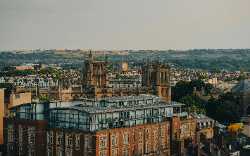
Bristol is one of England’s most distinctive cities, a place where history, creativity, and a spirit of independence meet. Sitting on the River Avon and close to the Severn Estuary, it has long been shaped by water. Its harbour was once the centre of maritime trade, sending ships across the world, and today that same waterfront has been transformed into a lively cultural hub filled with museums, galleries, restaurants, and music venues. Walking through Bristol, you quickly sense its mix of old and new. Medieval churches and Georgian terraces stand beside bold street art and modern architecture. The city is famously linked with Banksy, and his work still decorates walls across neighbourhoods like Stokes Croft, making Bristol something of an open-air gallery. One of its most iconic sights is the Clifton Suspension Bridge, designed by Isambard Kingdom Brunel. Spanning the dramatic Avon Gorge, it has become a symbol of the city and a must-visit viewpoint. Brunel’s influence can also be seen in the SS Great Britain, once the largest ship in the world, now beautifully restored and moored in the harbour where visitors can step back into the 19th century. Bristol’s character is shaped by its people – inventive, outward-looking, and proud of their independent identity. The city has a strong musical heritage, from the trip-hop sounds of Massive Attack and Portishead to its thriving live music scene today. It is also known for its festivals, from the famous International Balloon Fiesta, where hundreds of hot air balloons rise over the city, to Harbour Festival celebrations along the docks. Green spaces are never far away, with parks like Brandon Hill offering views over the rooftops and Leigh Woods providing calm on the edge of the gorge. The surrounding countryside, including the Cotswolds and Somerset, adds to Bristol’s appeal as a gateway to the southwest. What makes Bristol so engaging is its balance – it feels historic yet modern, energetic yet relaxed. Whether you’re exploring its harbourside, wandering through Clifton’s elegant streets, or simply soaking up its creative spirit, Bristol leaves an impression of a city that values both its roots and its constant reinvention.
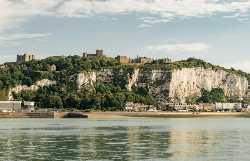
Dover, perched on the southeastern coast of England, is a town that has long stood as a gateway between Britain and continental Europe. Known worldwide for its iconic White Cliffs, this historic port town is far more than just a place of arrival and departure — it is a destination in its own right, rich in history, culture, and striking natural beauty. At the heart of Dover’s story is its castle, often referred to as the “Key to England.” Dover Castle dominates the skyline, a vast fortress that has guarded the coast for over 900 years. Within its walls, visitors can step back to medieval times, explore wartime tunnels carved deep into the cliffs, and witness the commanding views across the English Channel. On clear days, the coast of France is visible just 21 miles away, a reminder of Dover’s role as the closest English point to mainland Europe. Equally captivating are the White Cliffs of Dover, symbols of resilience and homecoming. These chalk cliffs, with their dramatic views, walking trails, and rich wildlife, provide both peaceful escapes and breathtaking scenery. The cliffs are managed by the National Trust, offering visitors a chance to connect with nature while learning about the area’s importance during times of conflict. Dover is also home to unique cultural gems. The Bronze Age Boat, housed in Dover Museum, tells the story of one of the world’s oldest known sea-going vessels. The town’s transport and military museums highlight Dover’s long relationship with travel, trade, and defense. Local galleries and theatres, though small, bring modern creativity into the town’s historic fabric. The bustling Port of Dover remains Europe’s busiest ferry terminal, a place where thousands of travelers pass daily, yet the town itself offers quiet charm beyond the movement of ships. Seafront promenades, pebble beaches, and nearby villages like St Margaret’s Bay create opportunities to slow down and explore coastal life. With its blend of history, dramatic landscapes, and role as Britain’s front door, Dover offers something rare: a place where past and present stand side by side, shaped by centuries of connection across the Channel. Whether you come to walk the cliffs, discover its castles and museums, or simply watch the ferries glide across the water, Dover leaves an impression that is both powerful and deeply human.
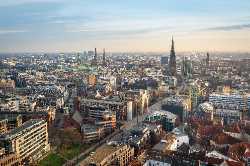
Hamburg, Germany’s great port city, is a place where water, history, and modern culture flow together. Often called the “Gateway to the World,” Hamburg has been shaped for centuries by its mighty harbor and its role in international trade. The River Elbe, with its countless canals and bridges, gives the city a character unlike anywhere else in Germany – in fact, Hamburg has more bridges than Venice, London, and Amsterdam combined. At the heart of the city lies the Altstadt, the old town, where the elegant Rathaus (Town Hall) stands as a symbol of wealth and resilience. Hamburg has endured fires, floods, and war, but each time it rebuilt itself with energy and pride. Today, historic brick warehouses in the Speicherstadt, the world’s largest warehouse district, are recognized as a UNESCO World Heritage Site. Nearby, the striking modern Elbphilharmonie concert hall rises like a glass wave above the harbor, combining old foundations with bold architecture – a symbol of Hamburg’s ability to blend past and future. Life in Hamburg is tied to the water. The Port of Hamburg is still one of Europe’s busiest, and visitors can watch giant container ships glide past or take a boat tour through the bustling harbor. The Inner and Outer Alster lakes, in the city center, offer a calmer side, where locals sail, jog along the waterfront, or simply relax at a café. Culturally, Hamburg is vibrant and diverse. It has Germany’s most famous red-light and entertainment district, the Reeperbahn, where The Beatles famously began their journey to stardom. Today, it’s a hub for nightlife, music, and theaters. Museums, from maritime history to contemporary art, add depth for curious travelers. Despite being a major metropolis, Hamburg is green and open. Parks, gardens, and riverside paths make it a city where nature is never far away. This mix of water, trade, culture, and relaxation gives Hamburg a unique rhythm – at once lively and laid-back. It’s a city that invites visitors to explore its harbors, stroll its historic streets, and discover why it has long been one of Europe’s most fascinating ports of call.
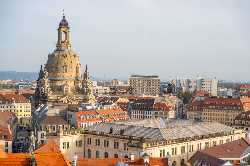
Dresden. The name itself is a study in contrasts, a word that simultaneously conjures up images of exquisite Baroque beauty and the terrifying specter of total annihilation. It is a city that has not merely recovered from tragedy but has fundamentally rebuilt its soul, stone by historic stone. Before 1945, Dresden was known as the "Florence on the Elbe," a celebrated title earned through centuries of patronage by Saxon royalty, particularly Augustus the Strong. This era saw the creation of a stunning Baroque skyline that was the envy of Europe. The Zwinger Palace, an opulent masterpiece of Rococo architecture and sculpture, served as an orangery and venue for royal festivals. Across the square stood the Residenzschloss (Royal Palace), and dominating the skyline was the majestic, bell-shaped dome of the Frauenkirche (Church of Our Lady). The city was, in a word, a "Jewel Box," holding world-class treasures like the art in the Old Masters Picture Gallery and the glittering wealth of the Green Vault. Then came the firestorm of February 1945. In the closing months of World War II, Allied bombing raids reduced the historic core to a wasteland of rubble and ash. The devastation was near-total, turning centuries of cultural heritage into a global symbol of wartime horror. For nearly fifty years under the German Democratic Republic (East Germany), the blackened ruins of the Frauenkirche were intentionally left as a stark, powerful anti-war memorial. Other key structures, like the Semperoper (Opera House) and the Zwinger, were painstakingly reconstructed, but the church remained a gaping wound in the city’s heart. The modern chapter of Dresden began after German reunification. Driven by a powerful civic movement and international donors—including former Allied countries—the decision was made to rebuild the Frauenkirche. It was a monumental project, using salvaged, coded stones mixed with new ones, a living mosaic of destruction and hope. Its re-consecration in 2005 marked the completion of a truly symbolic act: a city reclaiming its history not through forgetfulness, but through relentless, detailed reconstruction. Today, Dresden is a vibrant blend of the old and the new. You can stroll across the Brühl's Terrace, dubbed the "Balcony of Europe," gaze upon the Fürstenzug (Procession of Princes), a massive mural of Saxon rulers made from 23,000 Meissen porcelain tiles, and attend an opera in the lavishly restored Semperoper. Beyond its Baroque core, modern Dresden thrives as a center for high-tech industry, particularly microelectronics—earning it the nickname "Silicon Saxony." Its youthful energy and cultural depth, from the world’s oldest Christmas market (Striezelmarkt) to its edgy Neustadt district, prove that its spirit, like its architecture, could rise again. The history of Dresden is a profound lesson in resilience. It is a place that shows the world that a city can be erased and, through sheer human will, be born anew, forever aware of its past while firmly focused on its future.
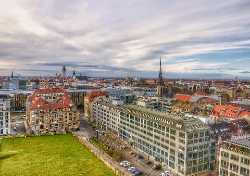
Leipzig is a city of profound contrasts, a place where the intricate harmonies of classical music and the hushed power of revolution coexist. It is not Germany’s largest metropolis, but its influence on European culture and history is monumental. Its soul is musical. This is the city of Johann Sebastian Bach, who served as the Thomaskantor for 27 years (1723–1750) at the St. Thomas Church (Thomaskirche), composing many of his masterworks here, and where his remains are interred. The St. Thomas Boys Choir (Thomanerchor) continues his legacy, its centuries-old tradition a living link to the Baroque era. Just as vital is the Gewandhaus Orchestra, one of the world's oldest and finest, founded by local merchants. This tradition attracted other giants: Felix Mendelssohn founded Germany's first conservatory here, and Robert and Clara Schumann made their home and music in the city’s vibrant intellectual scene. Leipzig’s music heritage is the sound of European genius. Yet, its most pivotal moment was a moment of silence and courage. In 1989, Leipzig became the unlikely epicenter of the Peaceful Revolution. For years, dissidents had gathered for weekly Prayers for Peace at the St. Nicholas Church (Nikolaikirche). These quiet gatherings swelled until, on October 9, 1989, over 70,000 people risked their lives to march around the city ring, facing down armed security forces. Their chant, "Wir sind das Volk!" ("We are the people!"), was not a violent roar, but a united demand for democracy. This non-violent protest, born from the strength found within a church, broke the will of the East German communist regime. Leipzig's “Monday Demonstrations” set the stage for the fall of the Berlin Wall a month later, earning it the nickname "Hero City." Beyond music and revolution, Leipzig is defined by commerce. As a medieval crossroads for the Via Regia and Via Imperii, it became a premier trade center, pioneering the modern Trade Fair (Messe) system. This mercantile spirit is visible today in the stunning Old Town Hall and the elegant shopping arcades like the Mädler-Passage, reflecting centuries of bourgeois prosperity.
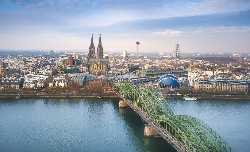
Cologne is Germany’s laid-back charmer—historic, quirky, and full of heart. It’s not just a city you visit; it’s one you feel. Sitting pretty on the banks of the Rhine River, Cologne (or Köln in German) is one of Germany’s oldest cities, with Roman roots and a skyline dominated by the awe-inspiring Cologne Cathedral. This Gothic masterpiece is the most visited landmark in Germany, and once you stand beneath its twin spires, you’ll understand why. But Cologne isn’t just about grand architecture—it’s about atmosphere. Wander through the Altstadt (Old Town) and you’ll find pastel-colored houses, cobbled lanes, and cozy beer halls serving up Kölsch, the local brew that’s light, crisp, and always poured with a smile. Locals are famously friendly and full of joie de vivre, especially during Carnival season when the whole city turns into a costumed street party. Art lovers will find plenty to admire, from the Museum Ludwig’s modern masterpieces to quirky spots like the Chocolate Museum, where you can learn about—and taste—sweet history. Cologne also has a Roman-Germanic Museum, showcasing the city’s ancient past, and a vibrant LGBTQ+ scene that makes it one of the most inclusive cities in Europe. The vibe here is relaxed. You don’t need a checklist—just stroll along the Rhine promenade, hop on a river cruise, or explore the Belgian Quarter’s indie boutiques and cafés. If you’re into street art, Ehrenfeld is your canvas. And for panoramic views, climb the cathedral tower or head to the KölnTriangle across the river. Cologne is easy to love and even easier to explore. Whether you’re here for the history, the beer, the art, or just the good vibes, this city welcomes you with open arms and a Kölsch in hand.
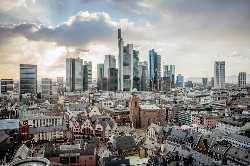
Frankfurt am Main, often simply called Frankfurt, is a city where old Europe and modern ambition blend into one unforgettable skyline. Rising proudly above the River Main, this financial capital of Germany is famous for its futuristic skyscrapers, historic charm, and international flair. At the heart of the city lies the Römerberg, Frankfurt’s beautiful old town square, lined with half-timbered houses and the iconic Römer, the city hall that has served since the 15th century. Just steps away stands Frankfurt Cathedral (Dom St. Bartholomäus), where emperors of the Holy Roman Empire were once crowned. The nearby Eiserner Steg, a graceful iron footbridge across the Main, offers one of the city’s best skyline views — especially at sunset. Frankfurt is also a city of art and ideas. Along the river’s southern bank stretches the Museumsufer, a cluster of world-class museums like the Städel Museum, German Film Museum, and Museum of Communication. Each tells a story of culture, creativity, and discovery that gives the city depth beyond its glass towers. For a taste of local life, stroll through the Kleinmarkthalle, where the aroma of fresh bread, sausages, and Apfelwein — the city’s famous apple wine — fills the air. Or relax in the Palmengarten, a lush botanical garden that feels worlds away from the busy financial district. Modern Frankfurt is home to the European Central Bank and the Frankfurt Stock Exchange, symbols of its global importance. Yet even amid the corporate energy, there’s a welcoming warmth — in cozy cafés, riverside walkways, and vibrant festivals like the Museumsuferfest and Christmas Market, one of Germany’s oldest. By night, the skyline of Frankfurt glows like a beacon of progress. But beneath its modern face lies a city deeply rooted in history, literature, and culture — the birthplace of Johann Wolfgang von Goethe and a gateway to both Germany’s past and its future. Frankfurt am Main isn’t just a stopover — it’s a place to slow down, look up, and feel the heartbeat of a city that never stops reinventing itself.
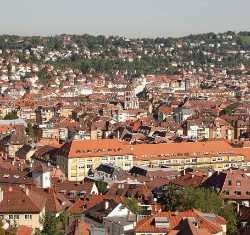
Stuttgart, the capital of Germany’s Baden-Württemberg region, is a city where innovation and tradition blend seamlessly. Nestled in a valley surrounded by rolling vineyards and forested hills, it offers a unique charm that combines industrial heritage with a love for nature and culture. Often called the “cradle of the automobile,” Stuttgart is home to two of the world’s most famous car brands: Mercedes-Benz and Porsche. Both companies have spectacular museums that showcase the evolution of automotive design and technology. The Mercedes-Benz Museum’s futuristic architecture mirrors the city’s forward-thinking spirit, while the Porsche Museum captures the essence of speed and style. Yet, Stuttgart is not all about engines and steel. At its heart lies Schlossplatz, the city’s main square, framed by the elegant New Palace (Neues Schloss) and the historic Old Castle (Altes Schloss). This area comes alive in every season — with fountains and street cafés in summer, and Christmas markets glowing with lights in winter. Just a short walk away is Königstraße, one of Germany’s longest pedestrian shopping streets, bustling with energy and lined with stores, restaurants, and cafés. Stuttgart’s landscape is one of its most defining features. The city sits in a basin, which gives it a unique skyline dotted with vineyards and viewpoints. Climb the Karlshöhe or the Killesberg Tower, and you’ll be rewarded with panoramic views that stretch across the city’s rooftops. The nearby Wilhelma Zoological and Botanical Garden — once a royal palace — offers another peaceful escape, combining exotic animals and lush gardens. Culture thrives here too. The State Gallery (Staatsgalerie) houses masterpieces from Rembrandt to Picasso, while the Stuttgart State Opera is considered one of the best in Europe. Festivals such as the Cannstatter Volksfest, a lively celebration of Swabian tradition, add warmth and fun to the city’s character. Stuttgart manages to feel both dynamic and relaxed — a place where technology meets art, and urban life flows gently into green hillsides. Whether you come for its world-class museums, historic architecture, or simply to enjoy a glass of local wine overlooking the city, Stuttgart leaves a lasting impression as one of Germany’s most surprising and elegant destinations.

Potsdam is more than just a beautiful collection of parks and palaces; it's a profound journey through German history, where the splendor of Prussian royalty and the gravity of Cold War politics intertwine. Often nicknamed the "Prussian Versailles," this city, located just southwest of Berlin, is a sprawling cultural landscape recognized as a vast UNESCO World Heritage Site. The heart of Potsdam's fame rests in its role as the second royal residence of the Prussian Kings, most notably under Frederick the Great. It was he who commissioned the iconic Sanssouci Palace, a masterpiece of German Rococo. Meaning "without a care" in French, the palace was Frederick's intimate summer retreat, set upon sun-drenched vineyard terraces. The surrounding Sanssouci Park is a breathtaking ensemble of architecture and nature, featuring the grander, more imposing New Palace, the charming Chinese Tea House, and the Roman Baths. Beyond Sanssouci, the city’s multifaceted heritage is revealed in its distinct quarters. The charming Dutch Quarter (Holländisches Viertel), built in the 18th century to attract Dutch craftsmen, stands out with its red-brick houses, gabled facades, and cozy courtyards, giving Potsdam a unique, almost Amsterdam-like feel. Another fascinating stop is the Russian Colony Alexandrowka, a picturesque settlement of wooden houses built for Russian singers in 1826. Potsdam’s narrative leaps from royal playground to a pivotal moment in global history at the Cecilienhof Palace. This grand, English Tudor-style country house in the New Garden hosted the Potsdam Conference in 1945, where Allied leaders Truman, Churchill, and Stalin met to decide the post-World War II order. A short distance away is the infamous Glienicke Bridge, known during the Cold War as the "Bridge of Spies," the eerie location for high-profile agent exchanges between East and West. Today, Potsdam is a vibrant blend of its royal past and modern life. It’s not just a city of historical monuments but also a thriving center for science, education, and film, home to the historic Babelsberg Film Studio. To walk through Potsdam is to step through centuries—from the refined elegance of Frederick the Great's world to the dramatic tension of a divided Europe—all set within a landscape meticulously designed as an enduring work of art.
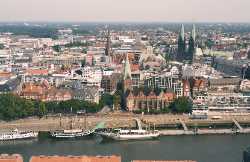
Bremen, one of Germany’s most charming and historic cities, lies on the banks of the River Weser in the country’s northwest. Known for its maritime heritage, fairy-tale charm, and centuries-old traditions, Bremen combines history and innovation in a way few cities do. At the heart of Bremen is the Marktplatz, one of the most beautiful squares in Europe. Here stands the Town Hall, a UNESCO World Heritage Site, admired for its striking Weser Renaissance façade. In front of it towers the Roland Statue, a symbol of freedom and independence since 1404. Together, they embody Bremen’s long-standing spirit of self-governance and civic pride. Just steps away is the St. Peter’s Cathedral, its twin spires dominating the skyline and offering a glimpse into more than 1,200 years of history. No visit to Bremen is complete without meeting the city’s most famous residents — the Town Musicians of Bremen. The bronze statue of the donkey, dog, cat, and rooster, inspired by the Brothers Grimm fairy tale, is a beloved landmark. Tradition says rubbing the donkey’s hooves brings good luck, and almost every visitor does. Wandering through the narrow lanes of the Schnoor Quarter feels like stepping into another century. This medieval district, filled with crooked half-timbered houses, cozy cafés, and artisan shops, is one of Bremen’s most picturesque corners. Another must-see is the Böttcherstraße, a masterpiece of expressionist architecture that links the market square to the river and features unique art galleries, workshops, and the famous Glockenspiel House. Bremen also embraces its maritime past with the Übersee-Museum, which explores global trade and cultures, and the Schlachte Embankment, a lively riverside promenade filled with restaurants, beer gardens, and moored ships. Modern Bremen, meanwhile, looks to the future with its Universum Science Center and strong presence in aerospace and renewable energy industries. Charming, cultural, and full of character, Bremen is a city where legend meets modern life — a place that captures the essence of northern Germany with warmth, wit, and a touch of magic.
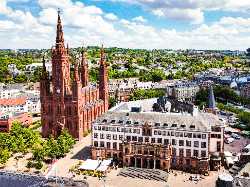
Nestled on the banks of the Rhine River, Wiesbaden is one of Germany’s most elegant and historic cities. As the capital of the state of Hesse, it is renowned for its thermal springs, refined architecture, and relaxed lifestyle that blends wellness, culture, and history in perfect harmony. Wiesbaden’s story dates back over 2,000 years when the Romans discovered its healing hot springs and established the settlement of “Aquae Mattiacorum.” These natural thermal waters still flow today, and the city remains a famous spa destination. Visitors can experience this tradition at the Kaiser-Friedrich-Therme, a beautiful Art Nouveau bathhouse built in 1913, where thermal pools and saunas draw on the same ancient springs once enjoyed by Roman soldiers and European nobility. The cityscape of Wiesbaden is a delight to explore. Stroll along Wilhelmstraße, the city’s grand boulevard lined with boutiques, cafés, and elegant 19th-century villas. At its end lies the Kurhaus, a stunning neoclassical building that serves as the city’s cultural heart and casino. Behind it, the Kurpark offers peaceful lakes, fountains, and shaded paths perfect for leisurely walks. Wiesbaden is also known for its architectural gems, from the red-brick Marktkirche on Schlossplatz to the stately New Town Hall and the opulent State Theatre. Nearby, the Neroberg Hill provides one of the best panoramic views over the city and the Rhine Valley. Visitors can reach it via the charming Nerobergbahn, one of the world’s oldest water-powered funicular railways. At the top, the golden-domed Russian Orthodox Church of Saint Elizabeth gleams in the sunlight, a reminder of the city’s long connection with European aristocracy. Beyond its beauty, Wiesbaden is a city of wellness, wine, and sophistication. It lies in the heart of the Rheingau wine region, making it a perfect base for tasting world-class Rieslings along the scenic river valley. With its elegant atmosphere, rich history, and rejuvenating spirit, Wiesbaden is truly a place where culture and relaxation meet — a timeless destination that captures the essence of refined German charm.
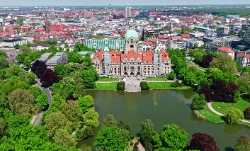
Hanover (Hannover in German), the capital of Lower Saxony, is a vibrant city that combines rich history, elegant architecture, and lush nature. Known for its royal gardens, world-class exhibitions, and cultural charm, it’s one of Germany’s most inviting destinations for visitors who love both city life and the outdoors. At the heart of Hanover lies the New Town Hall (Neues Rathaus), an impressive architectural masterpiece built in 1913. Its majestic dome offers a unique diagonal elevator ride to a panoramic viewing platform, revealing breathtaking views of the city’s skyline and nearby Maschsee Lake. Nearby, the Old Town (Altstadt) charms visitors with cobbled streets, half-timbered houses, and cozy cafés that give a glimpse of Hanover’s medieval soul. One of Hanover’s true highlights is the Herrenhausen Gardens, a masterpiece of Baroque landscape design. Once the summer residence of the royal family, the gardens are a peaceful haven of fountains, sculptures, and perfectly trimmed hedges — earning Hanover the nickname “City of Gardens.” The nearby Berggarten hosts rare plant species and an elegant orchid collection, attracting nature lovers all year round. Culture thrives throughout the city. The Sprengel Museum is a must-see for modern art enthusiasts, while the Hanover State Opera House offers world-class performances. Music lovers might also explore the city’s connection to rock legend Scorpions, who started their career here. Hanover is also a global hub for innovation — home to the Hannover Messe, one of the world’s largest industrial technology fairs. During this event, the city transforms into a meeting point for inventors, entrepreneurs, and visionaries. With vast green spaces, lakeside promenades, and a relaxed atmosphere, Hanover perfectly blends urban sophistication with natural beauty. Whether you’re exploring royal history, enjoying a lakeside walk, or diving into modern culture, Hanover welcomes you with a mix of elegance and warmth that defines the best of northern Germany.
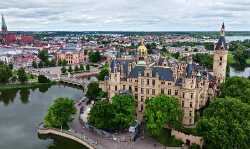
Schwerin, the capital of the northeastern German state of Mecklenburg-Vorpommern, is a city steeped in history and picturesque charm. Known as the "Venice of the North" due to its location amidst seven lakes, Schwerin’s most iconic landmark is the fairy-tale Schwerin Castle. This magnificent castle, situated on an island in Lake Schwerin, was the residence of the Dukes and Grand Dukes of Mecklenburg for centuries and today houses the state parliament. Since 2024, the castle, along with its surrounding historic residential buildings, has been recognized as a UNESCO World Heritage Site. With a population just under 100,000, Schwerin is Germany’s smallest state capital, yet it offers a rich blend of cultural experiences and architectural heritage. The roots of Schwerin stretch back over a millennium to its first mention in 1018 and its establishment as a Slavic settlement known as Zuarina. In 1160, Henry the Lion conquered the area, leading to its development as a German town and the construction of a strategic fortress on Lake Schwerin’s shores. Over time, the city grew into a political and cultural center, serving as the seat of the Duchy of Mecklenburg-Schwerin. The 19th century was a period of transformation for the city, marked by architectural enhancements including the redesign of the Schwerin Castle into a stunning example of Romantic historicist style by renowned architects such as Gottfried Semper. Schwerin's cityscape is characterized by well-preserved historical architecture, including the Gothic Schwerin Cathedral dating back to the 13th century, Baroque palaces, and the State Museum, which features notable art collections. Despite the ravages of two World Wars, Schwerin managed to retain much of its old-world charm, with careful post-war restoration ensuring its historical integrity. The city is surrounded by beautiful lakes, parks, and gardens, making it an attractive destination for both nature lovers and history enthusiasts. Cultural life in Schwerin is lively, with a calendar filled with festivals such as the Schlossfestspiele, a renowned castle theatre festival, the Old Town Festival, and the romantic Mäkelborg Christmas Market. Together with its museums, galleries, and architectural gems, Schwerin offers visitors a unique experience where history, nature, and culture combine seamlessly in one of northern Germany’s most enchanting cities. Schwerin stands today as a testament to its rich past and vibrant present, inviting exploration of its majestic castle, serene lakes, and the vibrant city life that flourishes within its historic walls.
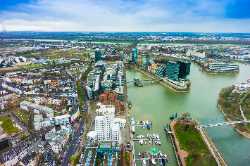
Düsseldorf, the capital of North Rhine-Westphalia, is one of Germany’s most elegant and dynamic cities — a place where tradition meets modernity along the scenic banks of the River Rhine. Known for its fashion, art, and lively atmosphere, Düsseldorf offers a perfect blend of culture, commerce, and charm. The city’s heart beats strongest along the Rhine embankment promenade, a beautiful riverside walkway where locals and visitors stroll, cycle, and relax with views of passing boats and the city skyline. Nearby lies the Altstadt, Düsseldorf’s Old Town, famous for its narrow cobbled streets and the so-called “longest bar in the world,” thanks to its hundreds of pubs, bars, and breweries. Here, visitors can taste the city’s signature dark beer, Altbier, brewed locally for centuries. Düsseldorf is also a hub of art and creativity. The Kunstpalast Museum and K20 & K21 art museums display everything from classic works to cutting-edge contemporary pieces. Fashion lovers know Düsseldorf as Germany’s style capital — the Königsallee, or “Kö,” is a glamorous boulevard lined with luxury boutiques, elegant cafés, and tree-shaded canals that give it a Parisian flair. Modern architecture also defines the city’s skyline. In MedienHafen, the redeveloped harbour district, futuristic buildings designed by world-renowned architects like Frank Gehry stand beside historic warehouses, symbolizing Düsseldorf’s ability to blend old and new. For panoramic views, the Rheinturm (Rhine Tower) offers a breathtaking observation deck and a revolving restaurant. Cultural highlights include the Düsseldorf Opera House, Tonhalle concert hall, and numerous festivals, such as the Carnival and the Japan Day, celebrating the city’s large Japanese community. Easily accessible and beautifully diverse, Düsseldorf is more than a business center — it’s a city of lifestyle, art, and openness. From riverside sunsets to avant-garde art and vibrant nightlife, Düsseldorf invites you to experience the best of urban Germany with a touch of elegance.

Mainz, the capital of Rhineland-Palatinate in western Germany, is a city where history, culture, and the spirit of the Rhine blend beautifully. Founded by the Romans over 2,000 years ago, Mainz lies on the west bank of the river Rhine, directly opposite Wiesbaden. Its charming old town, grand cathedral, and vibrant riverside life make it one of the most atmospheric cities along the Rhine. At the heart of Mainz stands the **Mainz Cathedral (Mainzer Dom)**, an impressive Romanesque structure with over a thousand years of history. The cathedral’s red sandstone façade dominates the skyline and its interior reveals layers of medieval and baroque architecture. Around the cathedral spreads the **Altstadt (Old Town)** — a maze of narrow streets lined with half-timbered houses, cozy wine taverns, and traditional shops. The **Markt Square** in front of the cathedral hosts the bustling weekly market and becomes especially lively during festivals. Mainz is world-famous as the hometown of **Johannes Gutenberg**, the inventor of the printing press. The **Gutenberg Museum**, located near the cathedral, displays original 15th-century printing presses and two priceless Gutenberg Bibles. This museum pays tribute to how Gutenberg’s innovation revolutionized communication and learning across Europe. Another highlight is the **Rhine Promenade**, where locals and visitors stroll along the river or enjoy a glass of local Riesling wine from the nearby Rheingau vineyards. The promenade offers spectacular views of passing boats, bridges, and sunsets over the water. In summer, the banks of the Rhine become a popular venue for open-air concerts and festivals such as **Mainzer Johannisnacht**, celebrating Gutenberg’s legacy with music, food, and fireworks. For those interested in Roman heritage, Mainz also preserves ancient ruins like the **Roman Theatre** and **Drususstein**, reminders of its past as a key military base of the Roman Empire. Art lovers will appreciate the **State Museum of Mainz** with its fine collection from antiquity to modern times. Mainz is not only a historical treasure but also a cheerful city full of life. Its friendly people, cultural richness, and beautiful river setting make it an ideal destination for visitors seeking both history and charm in the heart of Germany.

Nestled on the banks of the River Saar, Saarbrücken is the capital of Germany’s smallest non-city state, Saarland. This charming city, close to the French border, blends German precision with French flair, making it a fascinating destination for visitors who love history, art, and relaxed urban life. The origins of Saarbrücken reach back to the Roman era, but it truly flourished during the 18th century under the rule of Prince Wilhelm Heinrich of Nassau-Saarbrücken. His legacy is visible in the city’s baroque architecture, most notably the magnificent Ludwigskirche, one of Germany’s finest Protestant baroque churches. Nearby, the Saarbrücken Castle, overlooking the river, stands as a proud reminder of the city’s long and turbulent past. Rebuilt several times, today it houses the Regional History Museum and hosts cultural events. The Alt-Saarbrücken district is filled with elegant squares, such as Schlossplatz and St. Johanner Markt, where colourful façades and lively cafés create a welcoming atmosphere. The market square is a favourite meeting point for locals, buzzing with life, especially on sunny days. The Old Bridge (Alte Brücke), dating back to 1546, connects the old town with the modern city centre and offers beautiful river views. Art lovers will find Saarbrücken particularly appealing. The Saarland Museum showcases works from the Middle Ages to contemporary art, while the Modern Gallery (Moderne Galerie) presents masterpieces by artists like Picasso, Miró, and Klee. The State Theatre (Staatstheater Saarbrücken) adds elegance and sophistication to the cultural scene with opera, ballet, and drama performances. Nature is never far away. The Deutsch-Französischer Garten (Franco-German Garden) symbolizes friendship between the two nations and offers peaceful lakes, fountains, and walking paths. For panoramic views, visitors can climb to the Saarbrücken Castle terrace or explore nearby attractions like the Völklingen Ironworks, a UNESCO World Heritage Site only a short drive away. Saarbrücken’s blend of history, culture, and cross-border charm makes it a hidden gem in southwestern Germany. Whether you’re enjoying a French-style pastry at a local café, admiring baroque landmarks, or relaxing by the Saar River, the city’s welcoming spirit and multicultural character make every visit memorable.
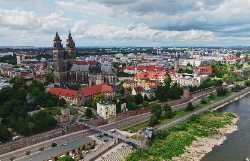
Magdeburg, the capital of Saxony-Anhalt, is one of Germany’s oldest cities and a place where history and modern life blend seamlessly. Founded over 1,200 years ago, Magdeburg rose to great importance under Emperor Otto the Great, who made it an imperial residence. His legacy still shapes the city today, especially through the majestic Magdeburg Cathedral, the first Gothic cathedral built on German soil. Its twin towers dominate the skyline and house the tomb of Otto the Great, making it one of the most significant spiritual landmarks in the country. Walking through the historic city centre, visitors discover a mix of medieval remnants, grand 19th-century buildings, and contemporary architecture. Much of the city had to be rebuilt after heavy damage in World War II, giving Magdeburg a unique cityscape where old and new stand side by side. A striking example of modern design is Hundertwasser’s Green Citadel, a colourful, organic-style complex filled with trees, apartments, shops, and a playful courtyard that reflects the artist’s vision of harmony between people and nature. The Elbe River shapes everyday life in Magdeburg. Wide riverbanks, parks, and cycle paths invite visitors to relax or explore, while the impressive Water Bridge, Europe’s longest navigable aqueduct, showcases the city’s engineering achievements. Nearby, the Elbauenpark offers the perfect combination of recreation and innovation, featuring the Millennium Tower, a 60-metre wooden structure presenting 6,000 years of science and technology. Magdeburg is also a vibrant cultural centre. Its theatres, museums, music festivals, and lively student population bring energy to the city throughout the year. Whether exploring historical treasures, enjoying riverside views, or discovering modern architecture, Magdeburg offers a rich and varied experience that surprises many first-time visitors.
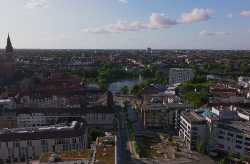
Kiel, the capital of Schleswig-Holstein, sits at the edge of the Baltic Sea where the Kiel Fjord meets the land, giving the city its strong maritime heartbeat. Known for its fresh sea breeze, sailing culture, and relaxed northern atmosphere, Kiel blends naval tradition with modern coastal living. The city’s waterfront is its most striking feature. Strolling along the Kiellinie promenade, visitors enjoy views of sailboats, research vessels, and the massive ferries departing for Scandinavia. The Kieler Förde is also home to the world-famous Kiel Week (Kieler Woche), one of the largest sailing events in the world. Each June, the city comes alive with regattas, open-air concerts, street food, and a vibrant festival spirit. Kiel has a rich naval history. The Schleswig-Holstein Naval Memorial and the nearby U-995 submarine in Laboe offer a striking look into Germany’s maritime past. Within the city, the Old Botanical Garden provides a peaceful escape with rare plants and panoramic views over the fjord. The historic city center combines modern architecture with remnants of the old town. The St. Nikolai Church, dating back to the 13th century, stands as the main medieval landmark, while the bustling Holstenstraße is one of Germany’s oldest pedestrian shopping streets. Nearby, the Kiel City Hall with its 106-meter tower offers elevated views of the harbor and skyline. Kiel is also known for its strong academic presence. The Christian-Albrechts-University attracts students from around the world and adds youthful energy to the city cafés, bars, and cultural programs. Whether you come for sailing, seaside walks, maritime history, or simply the calm northern atmosphere, Kiel offers a refreshing and authentic coastal experience. It is a city shaped by the sea—welcoming, windy, and full of character.

Erfurt, the capital of Thuringia, is one of Germany’s most charming and best-preserved medieval cities. Located at the crossroads of ancient European trade routes, it has been a significant cultural and commercial centre for more than 1,200 years. Today, visitors are drawn to its beautifully restored old town, impressive churches and relaxed Central-European atmosphere. The heart of Erfurt is the Domplatz, one of the largest and most picturesque squares in Germany. Towering above it are Erfurt Cathedral (Dom St. Marien) and the Severikirche, two monumental structures standing side by side on a dramatic staircase. The cathedral’s Gothic interior showcases stunning stained-glass windows and the medieval Gloriosa bell, the largest free-swinging bell of its kind in the world. A short walk leads into the maze of narrow streets and timber-framed houses that give the city its unique charm. The most iconic sight is the Krämerbrücke, a medieval bridge lined with half-timbered buildings. Still inhabited and filled with artisan shops, studios and cafés, it feels like stepping into a living historical postcard. It is one of the few bridges in Europe built entirely with houses across its full length. Erfurt is also well known for its religious heritage. In the 16th century, Martin Luther lived and studied here at the University of Erfurt and took his vows in the Augustinian Monastery. This beautifully preserved complex offers guided tours that trace Luther’s life and the spiritual history of the city. Beyond its medieval appeal, Erfurt features modern cultural highlights. The egapark, one of Germany’s largest horticultural parks, offers themed gardens, exhibitions and panoramic views from the Cyriaksburg fortress. Families enjoy the Zoopark Erfurt, one of the biggest zoological gardens in the country. With its mix of vibrant squares, peaceful riverbanks along the Gera and a lively café culture, Erfurt blends history with an easy-going lifestyle. Whether you come for its architecture, its connection to Luther, or simply its warm atmosphere, Erfurt offers a memorable journey into the heart of medieval Germany.
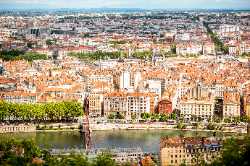
Lyon, the third-largest city in France, is a vibrant destination where 2,000 years of history blend seamlessly with modern urban life. Located at the confluence of the Rhône and Saône rivers, the city is known for its Renaissance architecture, ancient Roman sites, and world-famous culinary traditions. Lyon’s compact centre makes it easy for visitors to explore its diverse neighbourhoods, each offering a unique atmosphere. The historic heart of Lyon lies in Vieux Lyon, one of Europe’s largest Renaissance districts. Its narrow cobbled streets, colourful façades, and hidden traboules—secret passageways once used by silk workers—create a sense of mystery and charm. Above the district stands the Basilica of Notre-Dame de Fourvière, whose hilltop viewpoint provides sweeping panoramas of the entire city. Just nearby, visitors can discover the Roman theatres of Fourvière, a reminder of the city’s origins as the ancient capital of Roman Gaul. Across the river, the Presqu’île district impresses with grand squares such as Place Bellecour and Place des Terreaux. This lively area is filled with shops, cafés, and cultural institutions, including the Museum of Fine Arts, often called a “little Louvre.” To the north lies the elegant Croix-Rousse hill, once the centre of Lyon’s silk industry; today it remains a creative neighbourhood with markets, murals, and a village-like feel. Lyon is also celebrated as the gastronomic capital of France. Traditional bouchons serve hearty dishes such as quenelles, sausages, and praline tarts, while the legacy of legendary chef Paul Bocuse lives on in local markets and restaurants. The Halles de Lyon – Paul Bocuse offers a paradise for food lovers, filled with cheeses, pastries, and regional delicacies. Modern architecture shines at the Confluence district, a striking eco-friendly area with bold buildings, riverside promenades, and the iconic Musée des Confluences. Parks such as the vast Parc de la Tête d’Or provide green escapes in the heart of the city. Blending rich heritage, exceptional cuisine, and dynamic neighbourhoods, Lyon offers an unforgettable experience for every visitor. Whether wandering its ancient streets or enjoying its modern vibrancy, Lyon stands as one of France’s most captivating cities.

Bordeaux, set along the graceful curve of the Garonne River in southwestern France, is a city that blends historic grandeur with modern energy. Often called the “Pearl of Aquitaine,” it is best known for its world-famous wines, but Bordeaux offers much more than vineyards. Its beautifully restored architecture, lively squares, and riverside promenades create an atmosphere that feels both refined and wonderfully relaxed. The heart of the city is the UNESCO-listed historic center, a showcase of 18th-century stone buildings, elegant boulevards, and monumental squares. Place de la Bourse, reflected in the iconic Miroir d’Eau, is one of the most photographed spots in France. Nearby, narrow medieval streets of the Saint-Pierre district invite visitors to explore charming cafés, boutique shops, and atmospheric courtyards. Bordeaux’s cultural life is equally rich. The Grand Théâtre, one of Europe’s most beautiful opera houses, stands as a symbol of the city’s long artistic tradition. Museums such as the Cité du Vin offer interactive journeys through the world of wine, while the Musée d’Aquitaine tells the story of the region from ancient times to today. One of Bordeaux’s greatest pleasures is its riverside. The renovated quays stretch for miles, perfect for cycling, strolling, or simply enjoying the sunshine. Across the river, the Bastide district offers quieter views and grand perspectives of the historic skyline. Of course, no visit is complete without experiencing Bordeaux’s vineyards. The surrounding countryside is home to legendary wine regions—Saint-Émilion, Médoc, Pessac-Léognan—where châteaux open their doors for tastings and tours. Each estate has its own character, from medieval villages to grand estates surrounded by perfectly aligned vines. Bordeaux is a city that moves at a pleasurable pace. Whether you’re admiring its harmonious architecture, tasting world-class wines, or wandering riverside paths, it offers a refined yet welcoming atmosphere. For visitors seeking history, culture, and exceptional gastronomy, Bordeaux is one of France’s most rewarding destinations.

Strasbourg, the capital of the Grand Est region, is one of Europe’s most captivating cities — a place where French elegance meets German tradition, and centuries of history live alongside modern European identity. Located on the banks of the Rhine River, the city has changed hands several times, giving it a unique cultural mix, visible in its architecture, cuisine, and everyday atmosphere. At the heart of Strasbourg rises its breathtaking Cathedral of Notre-Dame, a masterpiece of Gothic architecture. Its pink sandstone façade, delicate sculptures, and towering 142-metre spire make it one of the most impressive cathedrals in Europe. Inside, the famous astronomical clock draws visitors daily with its moving figures and centuries-old mechanical precision. Climbing the cathedral platform rewards you with panoramic views over the city’s tiled rooftops and the Black Forest in the distance. Just steps away lies La Petite France, the most picturesque district in Strasbourg. Narrow cobbled streets wind between canals and beautifully preserved half-timbered houses. Once home to tanners, millers, and fishermen, today it is the city’s postcard corner — ideal for strolling, photography, and enjoying Alsatian dishes like tarte flambée or choucroute in traditional restaurants. Strasbourg is also one of Europe’s political capitals. The European Parliament, the Council of Europe, and the European Court of Human Rights are all headquartered here, giving the city an international spirit. The modern glass buildings of the European quarter contrast with the medieval city centre, highlighting Strasbourg’s dual identity: historic yet forward-looking. Green spaces are an essential part of the city. The Parc de l’Orangerie, with its small lake, storks, and elegant gardens, is a favourite for locals and visitors alike. Strasbourg’s extensive network of cycle paths also makes it one of France’s most bike-friendly cities. With its festive Christmas market, UNESCO-listed old town, exceptional gastronomy, and welcoming atmosphere, Strasbourg is a destination full of charm. It is a city that feels both grand and intimate, a place where every corner tells a story and where two cultures meet in perfect harmony.
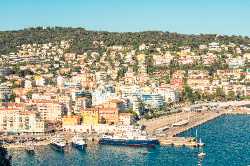
Nice, the radiant capital of the French Riviera, is a city where Mediterranean elegance meets a relaxed coastal lifestyle. Bathed in sunshine for more than 300 days a year, it attracts visitors with its vivid colors, vibrant culture, and timeless charm stretching from the turquoise sea to the surrounding hills. The heart of Nice is the famous Promenade des Anglais, a sweeping seaside boulevard lined with palm trees and historic hotels. Locals and visitors stroll, cycle, or simply sit along the pebbled beach, watching the sea shift from deep blue to shimmering silver. Just behind, the Old Town (Vieux Nice) offers a lively contrast: a maze of narrow streets filled with markets, small cafés, and pastel-hued buildings glowing in warm Mediterranean light. The Cours Saleya Market, with its flowers, produce, and Provençal specialties, captures the daily life and flavors of the region. Art lovers find inspiration in Nice’s impressive cultural scene. The Marc Chagall National Museum and Matisse Museum celebrate the city’s connection to artists who were drawn to its light and landscapes. Architectural elegance shines in landmarks such as the Russian Orthodox Cathedral, a reminder of the international influence that shaped Nice in the 19th century. For panoramic views, Castle Hill (Colline du Château) rewards visitors with sweeping scenes of the Bay of Angels, terracotta rooftops, and the dramatic coastline. Beyond the city, Nice serves as a perfect gateway to the Riviera’s treasures—Eze, Monaco, and Antibes are just a short journey away. Combining coastal beauty, artistic heritage, and a warm Mediterranean spirit, Nice remains a destination that surprises and delights, offering a uniquely French blend of sophistication and seaside simplicity.
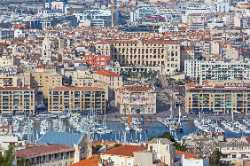
Marseille, the oldest city in France, is a vibrant Mediterranean port where history, cultures, and landscapes blend into a unique and unforgettable atmosphere. Founded by Greek sailors over 2,600 years ago, the city has always been a gateway between Europe and the wider world, giving it a distinctive character full of diversity, creativity, and energy. At the heart of Marseille lies the Vieux-Port, the Old Port, where fishing boats, terraces, and markets create a lively daily scene. From here, narrow streets lead into Le Panier, the historic district filled with colourful houses, local ateliers, and charming squares that reveal the city’s ancient past. Nearby, the iconic Cathédrale de la Major rises with its striking striped façade overlooking the sea. No visit to Marseille is complete without discovering Notre-Dame de la Garde, the city’s most famous landmark. Perched on a hilltop, the basilica offers panoramic views of the entire coastline, the islands of the Frioul archipelago, and the rugged beauty of the Calanques National Park. This protected area, located between Marseille and Cassis, is a paradise of turquoise waters, limestone cliffs, and hiking trails. Marseille is also a city of modern culture. The MuCEM—Museum of European and Mediterranean Civilisations—stands at the entrance to the port, blending contemporary architecture with ancient fortifications. It highlights the shared heritage of Mediterranean peoples and symbolises Marseille’s role as a crossroads of cultures. From bustling markets to beachfront promenades, from historical treasures to fresh seafood cuisine, Marseille offers visitors a rich and authentic experience shaped by centuries of exchange and the warmth of the Mediterranean sun.

Toulouse, often called La Ville Rose for its warm terracotta brick buildings, is one of France’s most atmospheric cities—a place where history, culture, science and a vibrant southern lifestyle blend effortlessly. Strolling through its sun-drenched streets, you immediately feel the unique character shaped by centuries of architectural beauty and the lively spirit of Occitanie. At the heart of the city lies the magnificent Place du Capitole, a grand square framed by the iconic Capitole building, home to the city hall and theatre. Its elegant façade reflects the golden tones of the region’s brickwork, especially magical during sunset. From here, narrow streets lead you to medieval treasures like the Basilique Saint-Sernin, one of the largest Romanesque churches in Europe and a key stop on the Camino de Santiago pilgrimage route. Toulouse’s connection with water is equally strong. The peaceful Garonne River divides the city, offering scenic walks, bridges and riverfront viewpoints—particularly stunning near the Pont Neuf. Not far away, the historic Canal du Midi, a UNESCO World Heritage Site, invites visitors to enjoy cycling paths, boat trips or quiet shaded strolls beneath centuries-old plane trees. Yet Toulouse is also a city of innovation. It is the European capital of aerospace, home to Airbus, the Cité de l’Espace and numerous scientific institutions. Visitors can explore real spacecraft, interactive exhibits and full-size rockets, celebrating the city’s role at the forefront of aeronautics. Culturally, Toulouse thrives with museums such as Musée des Augustins, Les Abattoirs and the charming Muséum de Toulouse, while its food scene highlights regional stars: cassoulet, foie gras, violet-flavoured sweets and vibrant markets like Marché Victor Hugo. Warm, welcoming and full of life, Toulouse offers the perfect mix of tradition and modernity. Whether for its historic heart, riverside charm, culinary delights or pioneering spirit, the Pink City leaves a lasting impression on every visitor.
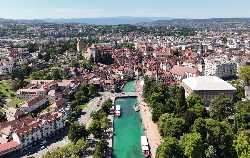
Annecy, often called “the Venice of the Alps,” is one of France’s most picturesque and peaceful cities. Set between the clear waters of Lake Annecy and the surrounding Alpine peaks, the town blends natural beauty with rich history and a relaxed, welcoming atmosphere. The heart of Annecy is its charming Old Town, where narrow canals flow beneath stone bridges and pastel-coloured houses. The Thiou Canal, one of Europe’s shortest rivers, adds a romantic touch, especially around the famous Palais de l’Isle, a 12th-century fortress shaped like a ship rising from the water. Just above the town, Château d’Annecy overlooks the roofs and channels, offering panoramic views and a journey through regional art and heritage. Lake Annecy is the city’s greatest treasure. Known as one of the cleanest lakes in Europe, its turquoise waters attract visitors all year round. In summer, people enjoy swimming, cycling along the lakeside paths, paddleboarding, and relaxing on the grass beaches of Albigny. Boat trips offer another way to admire the mountains reflected on the calm surface. Annecy is also a city of festivals and culture. The International Animation Film Festival, held every June, transforms the streets into a lively hub for artists, screenings, and animation fans from around the world. The markets, full of local cheese, Savoyard charcuterie, and fresh produce, keep the atmosphere vibrant throughout the week. For outdoor lovers, Annecy is a gateway to adventure. Nearby mountains provide countless hiking trails, while paragliders launch from Col de la Forclaz, colouring the sky above the lake. In winter, ski resorts are only a short drive away. Elegant yet simple, traditional yet lively, Annecy offers a perfect blend of alpine charm and lakeside tranquility. Whether you explore its medieval lanes, cruise across its crystal waters, or enjoy its natural landscapes, Annecy leaves a lasting impression of beauty, serenity, and timeless French character.
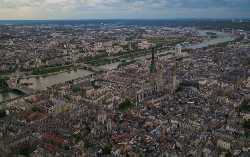
Rouen, the historic capital of Normandy, is a city where medieval charm and vibrant urban life blend effortlessly. Standing proudly on the banks of the River Seine, Rouen has long been a crossroads of culture, trade, and art. Its beautifully preserved old town, rich heritage, and atmospheric streets make it one of France’s most captivating cities. At the heart of Rouen rises the magnificent Cathédrale Notre-Dame, a masterpiece of Gothic architecture that inspired Claude Monet’s famous series of paintings. Its intricate façade, towering spires, and serene interior reflect centuries of craftsmanship and devotion. Not far away, the Gros-Horloge, a Renaissance astronomical clock arching over a lively pedestrian street, serves as a symbol of the city’s timeless character. Rouen’s history is also deeply connected to Joan of Arc, the iconic French heroine. Visitors can explore the Historial Jeanne d’Arc, a modern multimedia museum that traces her extraordinary story, or visit the spot where she was executed in 1431, now marked by the contemporary Église Sainte-Jeanne-d’Arc. The city’s medieval quarter is a delight to wander, with narrow lanes lined by colorful half-timbered houses and bustling cafés. Museums such as the Musée des Beaux-Arts showcase an impressive collection of paintings, including works by Caravaggio, Rubens, and Monet, underlining Rouen’s strong artistic legacy. Rouen is not only a city of the past. Its vibrant markets, riverside walks, and dynamic cultural scene bring energy and variety. From discovering Norman culinary classics to enjoying festivals and exhibitions throughout the year, Rouen offers an experience that is both enriching and welcoming. Steeped in history yet full of life, Rouen stands as one of France’s most beautiful and inspiring destinations—perfect for travellers who appreciate culture, architecture, and stories that have shaped a nation.
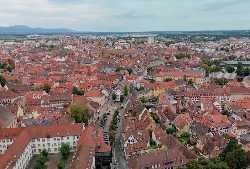
Colmar, often called the “Little Venice” of Alsace, is one of France’s most enchanting towns, known for its colourful half-timbered houses, peaceful canals, and a charm that feels almost fairy-tale like. Walking through Colmar’s old town is like stepping into a perfectly preserved medieval painting, where every corner reveals cobblestone lanes, blooming window boxes, and centuries of history. The heart of Colmar lies in its historic centre, a beautifully maintained district that escaped major damage during past conflicts. Here, visitors can admire iconic buildings such as the Maison Pfister, a Renaissance masterpiece with ornate wooden balconies, and the Koïfhus, the former customs house that reflects the town’s commercial importance. The Little Venice quarter is perhaps the most photographed area, with picturesque houses lining the tranquil Lauch River, offering perfect reflections at sunrise and sunset. Colmar is also deeply connected to art and culture. The Unterlinden Museum, housed in a former convent, showcases extraordinary works including the world-famous Isenheim Altarpiece, a masterpiece of German Renaissance painting. For wine lovers, Colmar is a gateway to the Alsace Wine Route, surrounded by vineyards producing exceptional Rieslings, Gewürztraminers, and Pinot Gris. Tasting rooms and wine festivals bring extra life to the town throughout the year. Despite its rich heritage, Colmar remains warm and inviting rather than overwhelming. Charming cafés, traditional winstubs, and lively markets create a friendly atmosphere where visitors can relax and enjoy regional specialities like tarte flambée, choucroute, and kougelhopf. Whether you arrive for its architecture, wine culture, or simply the magical ambiance, Colmar offers an unforgettable blend of beauty and authenticity, making it one of France’s most delightful destinations.
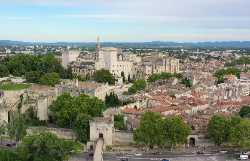
Nestled on the banks of the Rhône River in the heart of Provence, Avignon is a city whose very name is inseparable from one of the most dramatic periods in European history: the Avignon Papacy. This former capital of the Christian world offers visitors a rare concentration of medieval architecture and a vibrant modern cultural life, all encircled by exceptionally well-preserved ramparts. The historic center, along with its most iconic structures, was designated a UNESCO World Heritage Site in 1995. Avignon’s most defining landmark is the Palais des Papes (Palace of the Popes). In the 14th century, the papacy moved its seat from Rome to Avignon, and seven successive popes resided here for nearly 70 years, a period known as the Babylonian Captivity. Built between 1335 and 1352, the resulting monument is not only the largest Gothic palace in the world but also one of the largest and most fortified medieval structures in all of Europe. Its austere, castle-like exterior—a blend of the fortress built by Benedict XII and the more decorative palace of Clement VI—hides grand halls, ceremonial chambers, and the Popes' private apartments, once adorned with brilliant frescoes. Jutting out into the Rhône River are the remains of the legendary Pont Saint-Bénézet, known globally thanks to the children's song, “Sur le pont d'Avignon, on y danse, on y danse...” (On the bridge of Avignon, we dance there...). Originally constructed in the 12th century, the bridge once stretched nearly 900 meters across the river, but floods and military conflicts left only four of its original 22 arches standing. Though it famously no longer crosses the water, visitors can walk the remaining section and enjoy spectacular views of the Palace and the city’s skyline. Beyond its monuments, Avignon pulsates with life, particularly during the summer. Every July, the city transforms into the world's largest theatrical showcase for the Festival d'Avignon. This massive event, founded in 1947, sees performances taking place everywhere—from the great courtyard of the Palais des Papes to hidden side streets—infusing the old city with a youthful, artistic energy. Exploring the charming, winding streets within the city walls reveals elegant Renaissance mansions, hidden squares like the Place de l'Horloge, and lively markets, solidifying Avignon as the historical and cultural gateway to Provence.
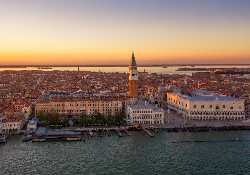
Venice, often referred to as "La Serenissima," is a masterpiece of human ingenuity and artistic brilliance. Rising from the waters of the Venetian Lagoon, this city is built upon an archipelago of 118 small islands, interconnected by over 400 bridges and separated by a labyrinth of winding canals. Unlike any other city in the world, Venice replaced paved roads with waterways, creating a silent, floating world where the rhythmic splash of gondola oars replaces the noise of modern traffic. Founded over 1,500 years ago by refugees fleeing mainland invasions, Venice grew into a formidable maritime republic. For over a millennium, it dominated trade between Europe and the East, accumulating vast wealth that was poured into magnificent marble palaces, ornate churches, and unparalleled works of art. This golden age is most evident in Piazza San Marco, the city's grandest square. Here, St. Mark’s Basilica stands as a testament to Byzantine influence, adorned with shimmering gold mosaics that have earned it the nickname "Church of Gold." Adjacent to it, the Doge’s Palace represents the pinnacle of Venetian Gothic architecture, having served for centuries as the heart of political power. The city’s pulse is best felt along the Grand Canal, a majestic S-shaped waterway lined with over 170 historic buildings. Spanning this canal is the iconic Rialto Bridge, a stone arch that has served as the commercial center of Venice since the Renaissance. Beyond the main thoroughfares, the city reveals its charms in the narrow alleyways, or "calli," of its six historic districts. Venice is also a sanctuary of craftsmanship; from the world-renowned glassblowing of Murano to the intricate lace-making of Burano, the city’s heritage is preserved by artisans who have passed down their skills through generations. It is a city of culture, home to the legendary La Fenice opera house and the vibrant traditions of the Venetian Carnival. However, the beauty of Venice is as fragile as it is profound. Today, the city faces the dual challenges of rising sea levels and overtourism. To protect its heritage, Italy has invested in the MOSE system—a series of mobile flood barriers—and recently introduced entry fees for day-trippers to manage the millions of annual visitors. Despite a declining local population that has dipped below 50,000 residents, Venice remains a poignant symbol of resilience. To visit Venice is to witness a city that defied the elements to become one of the most culturally significant places on Earth—a floating dream where history and water meet in eternal dialogue.
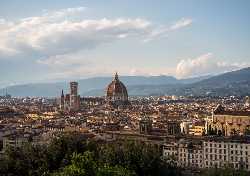
Florence, the capital of Italy’s Tuscany region, is often described as an "open-air museum." Nestled in a valley along the Arno River, this city served as the crucible of the Renaissance, a period of unprecedented intellectual and artistic blooming that changed the course of Western civilization. Its skyline is dominated by architectural marvels and its galleries house the world’s greatest concentration of Renaissance masterpieces, making it a place where history feels tangible in every cobblestone street. The undisputed heart of the city is the Piazza del Duomo, home to the Cathedral of Santa Maria del Fiore. Its massive red-tiled dome, engineered by Filippo Brunelleschi in the 15th century, remains the largest masonry dome in the world and an enduring symbol of Florentine ingenuity. Beside it stand Giotto’s Bell Tower and the Baptistery of St. John, famous for its bronze "Gates of Paradise." A short walk leads to the Piazza della Signoria, the city’s political center, dominated by the fortress-like Palazzo Vecchio and an array of outdoor sculptures that testify to the city’s historic power. Florence’s cultural wealth is largely thanks to the Medici family, the powerful banking dynasty that ruled the city for centuries. As visionary patrons, they funded the works of geniuses like Michelangelo, Leonardo da Vinci, and Botticelli. Much of their private collection is now housed in the Uffizi Gallery, one of the oldest and most famous art museums in the world. Nearby, the Accademia Gallery draws millions to witness Michelangelo’s David, a sculpture that embodies the Renaissance ideal of human strength and beauty. Connecting the bustling center to the quieter Oltrarno district is the Ponte Vecchio, the only bridge in the city to survive the bombings of World War II. This medieval stone arch bridge is unique for the jewelry shops that still line its sides, overhung by the secret Vasari Corridor used by the Medici to travel privately across the city. On the far side of the river lies the imposing Pitti Palace and the sprawling Boboli Gardens, a masterpiece of Italian landscaping. Beyond its physical beauty, Florence is the birthplace of the Italian language, largely through the works of the poet Dante Alighieri. From its culinary traditions like the Bistecca alla Fiorentina to its vibrant artisan workshops, Florence remains a living tribute to a golden age of human achievement, continuing to inspire visitors with its timeless elegance and spirit of discovery.